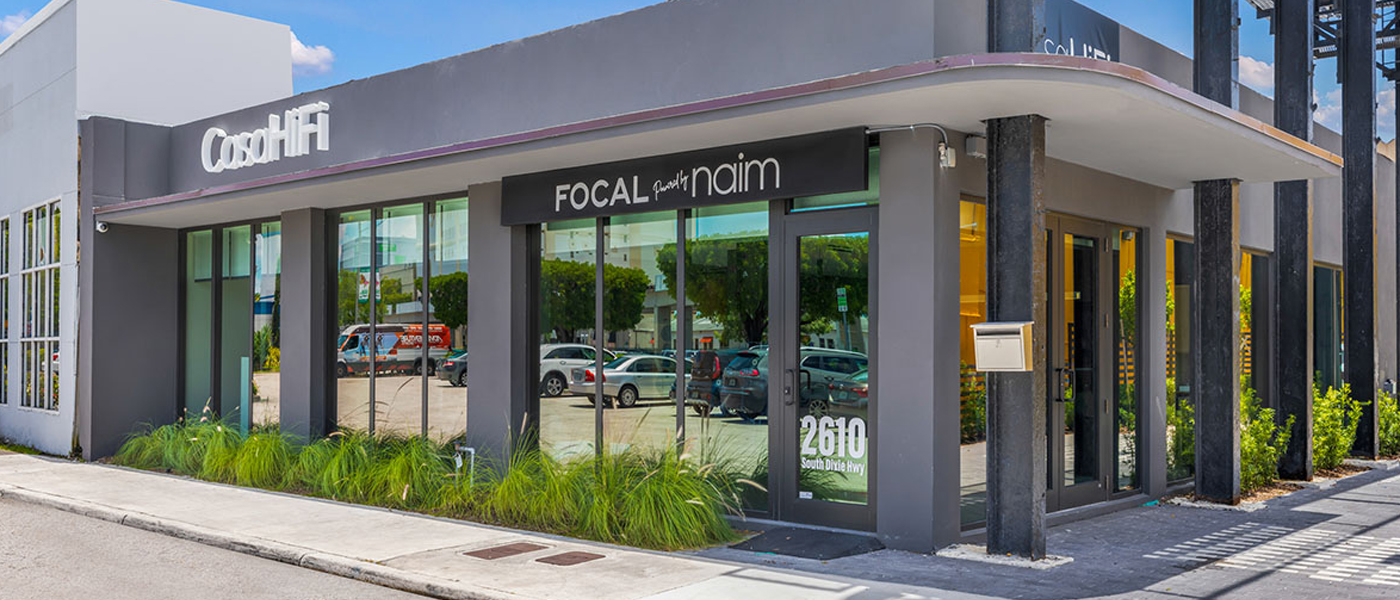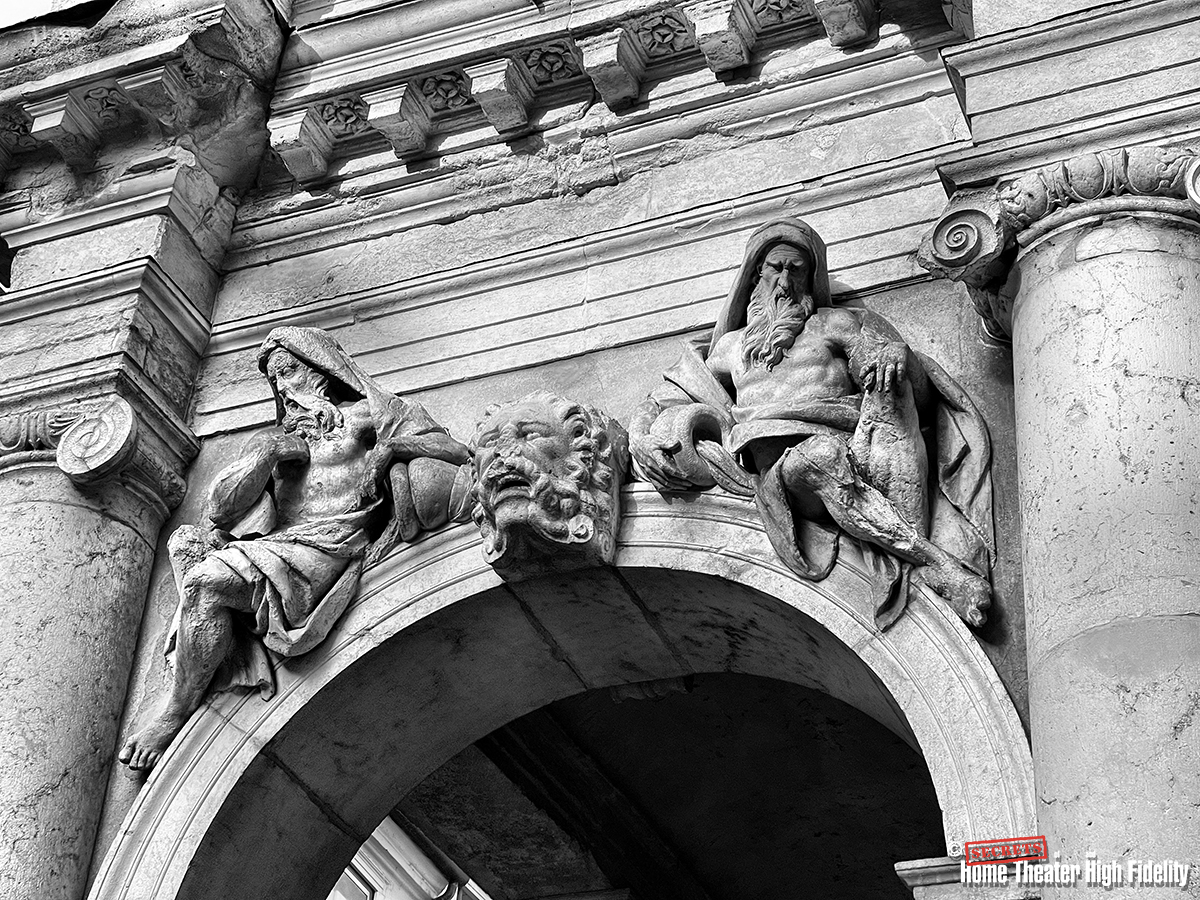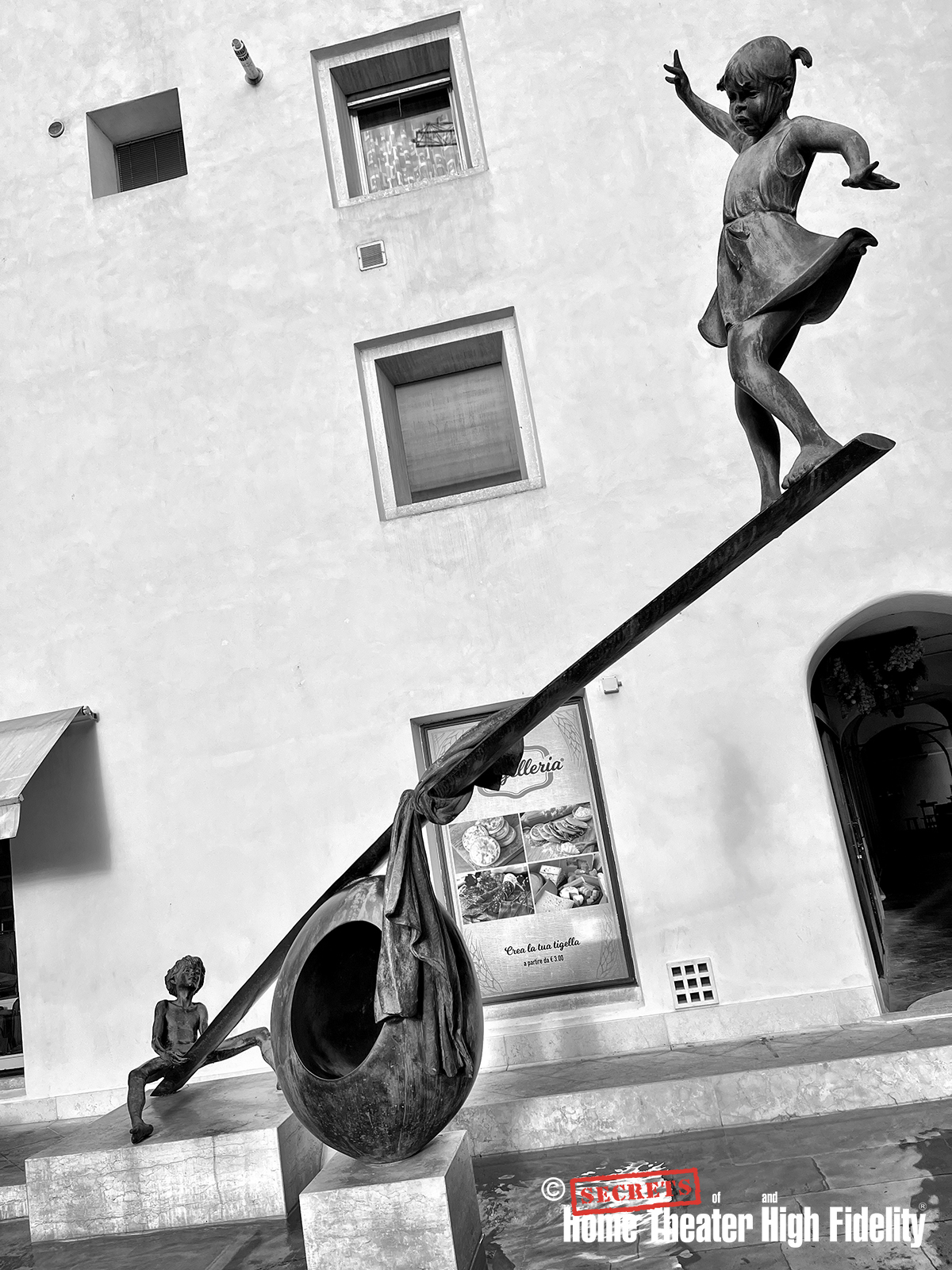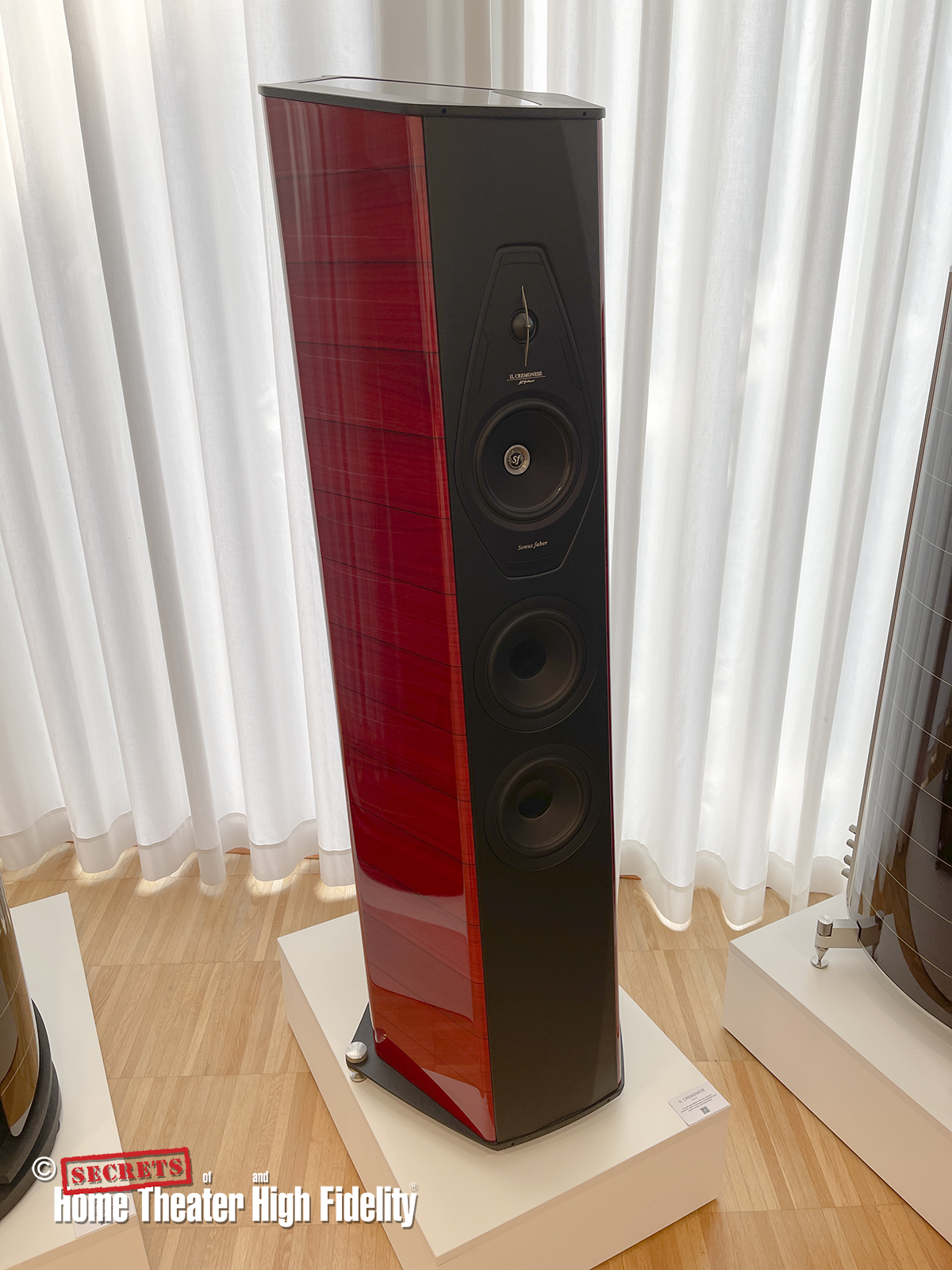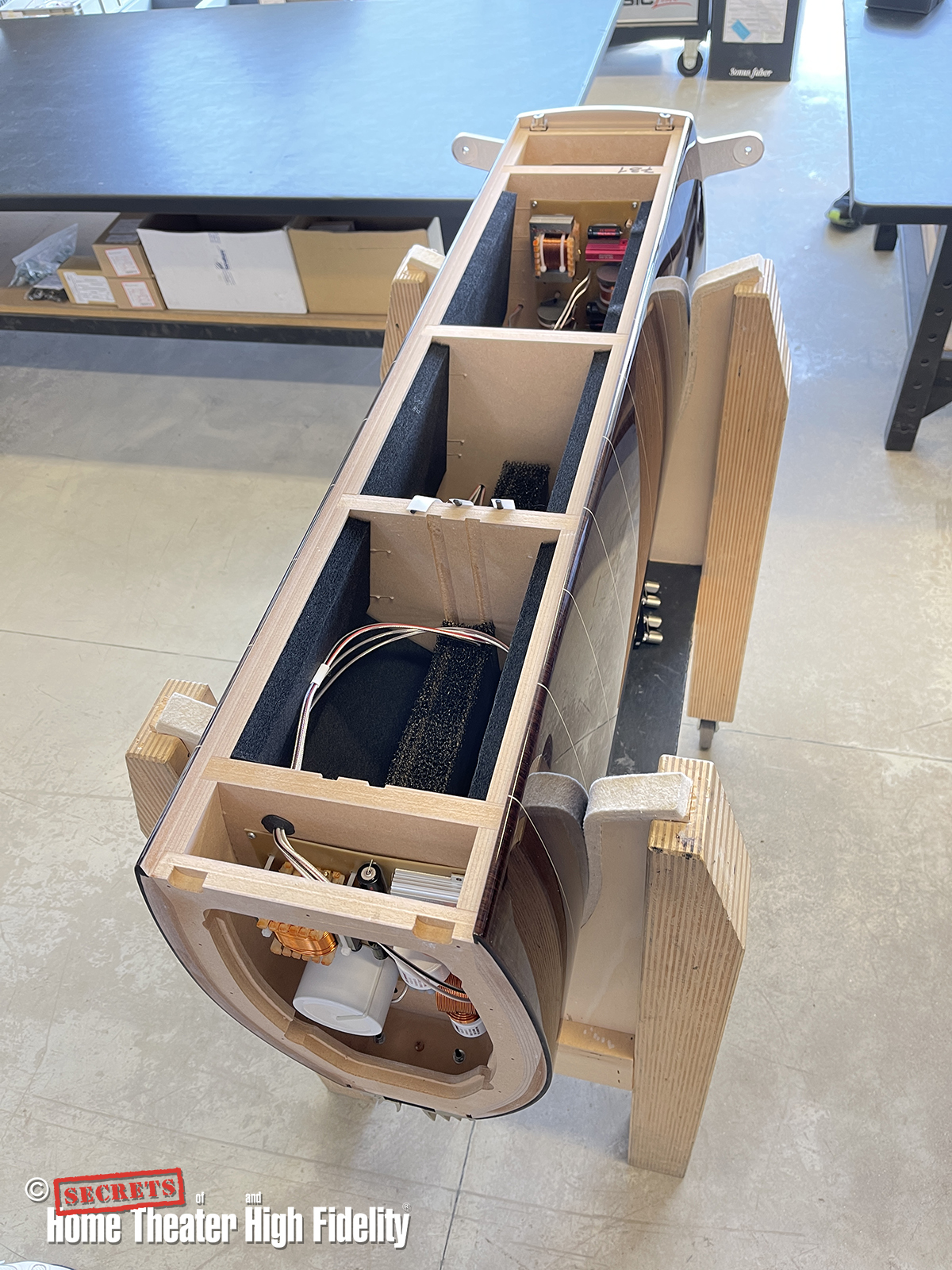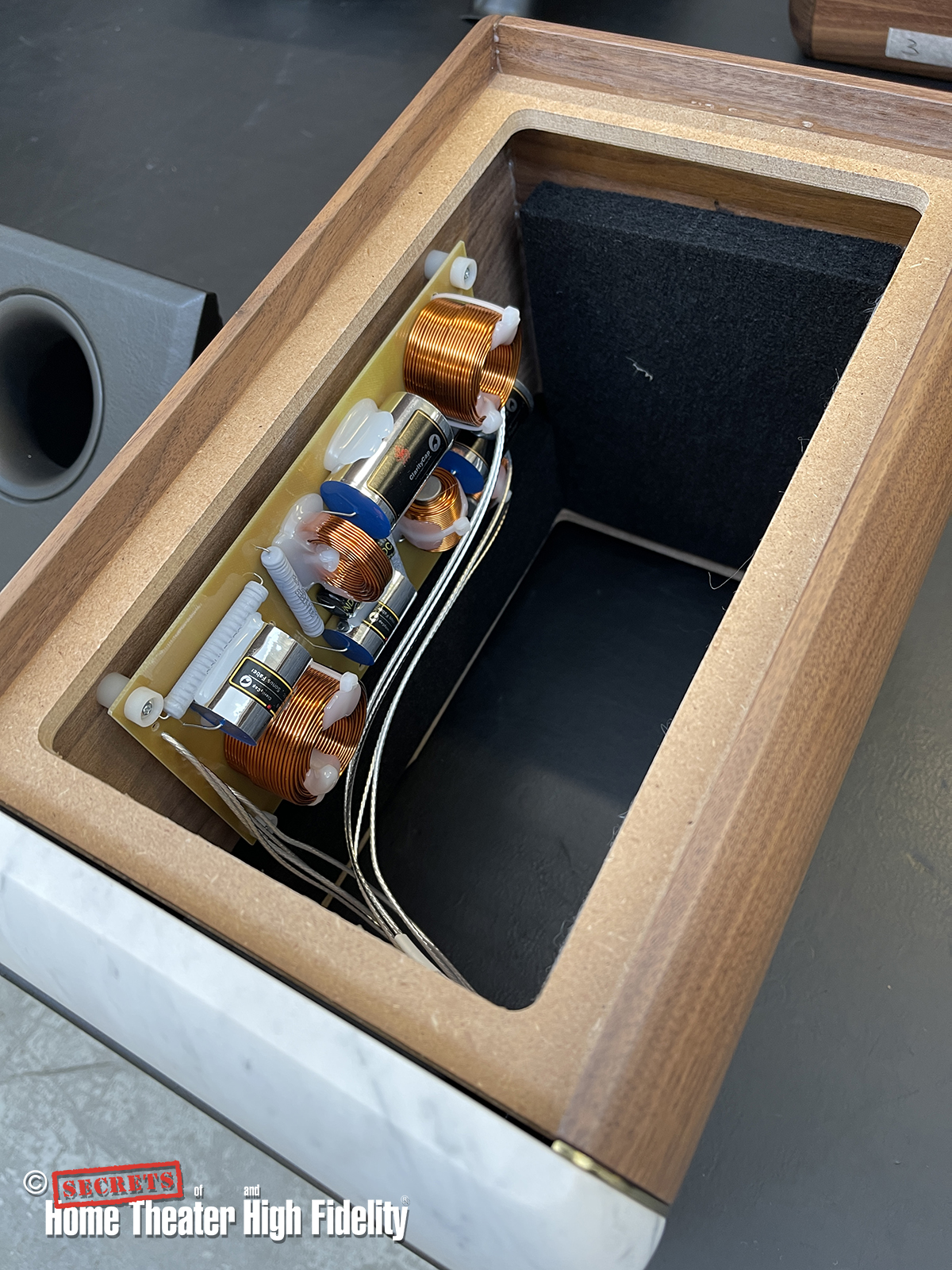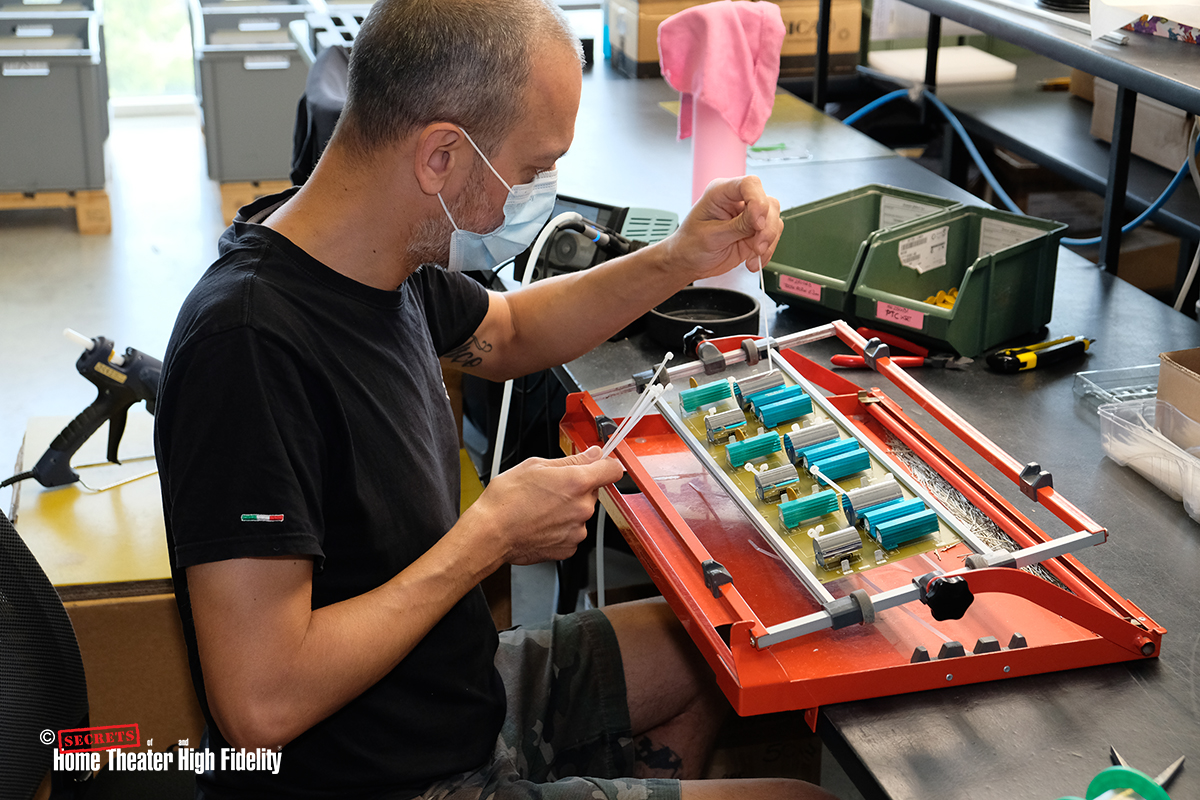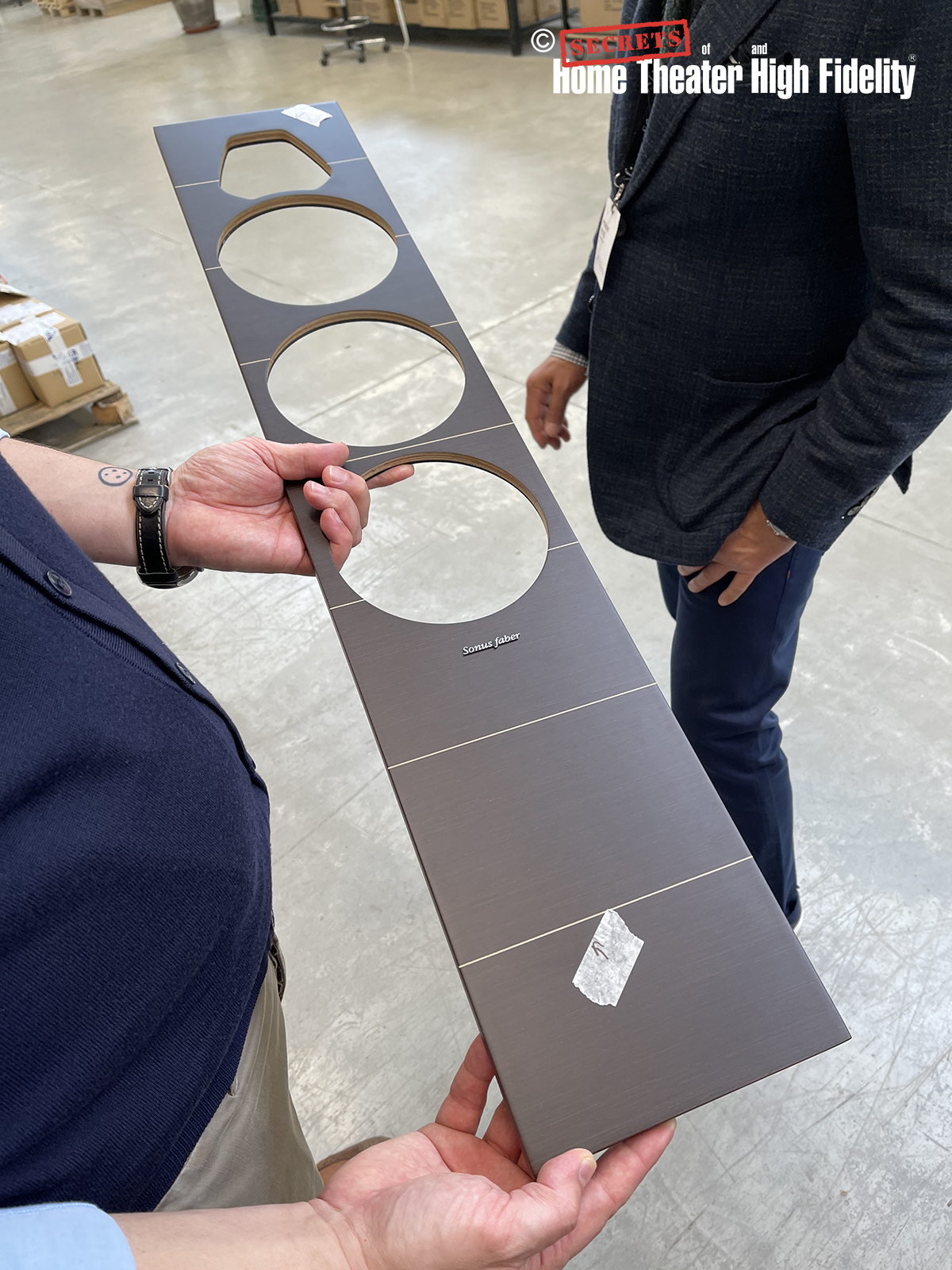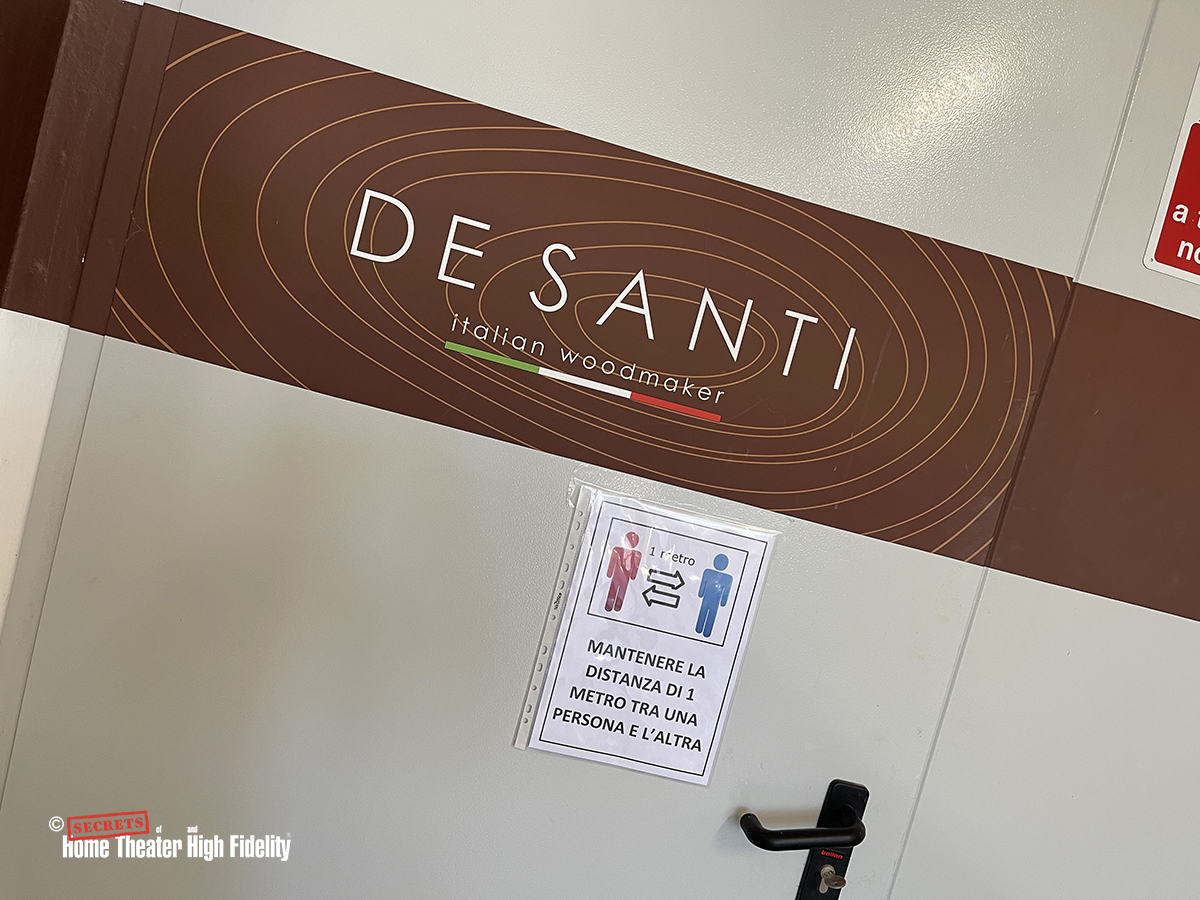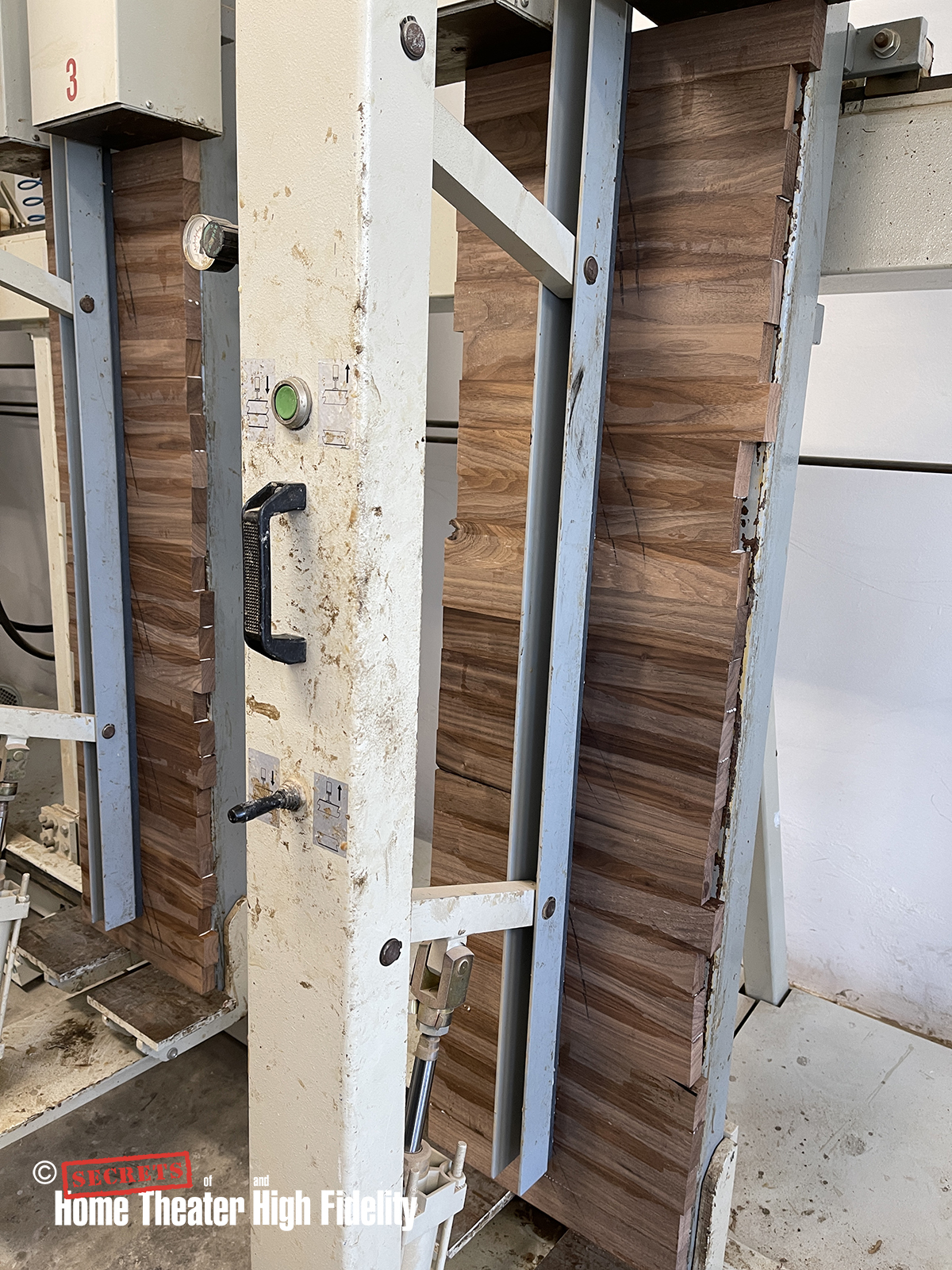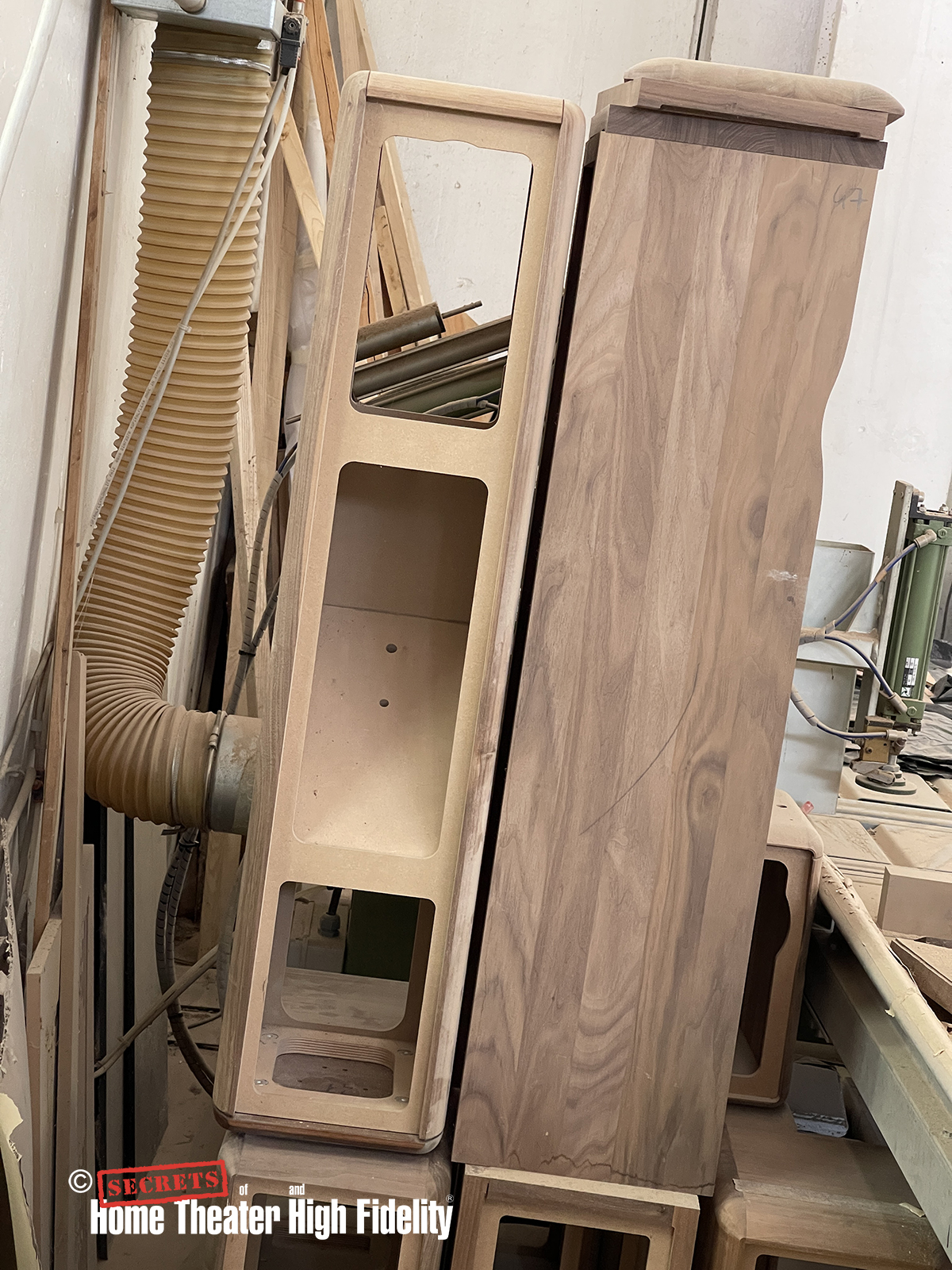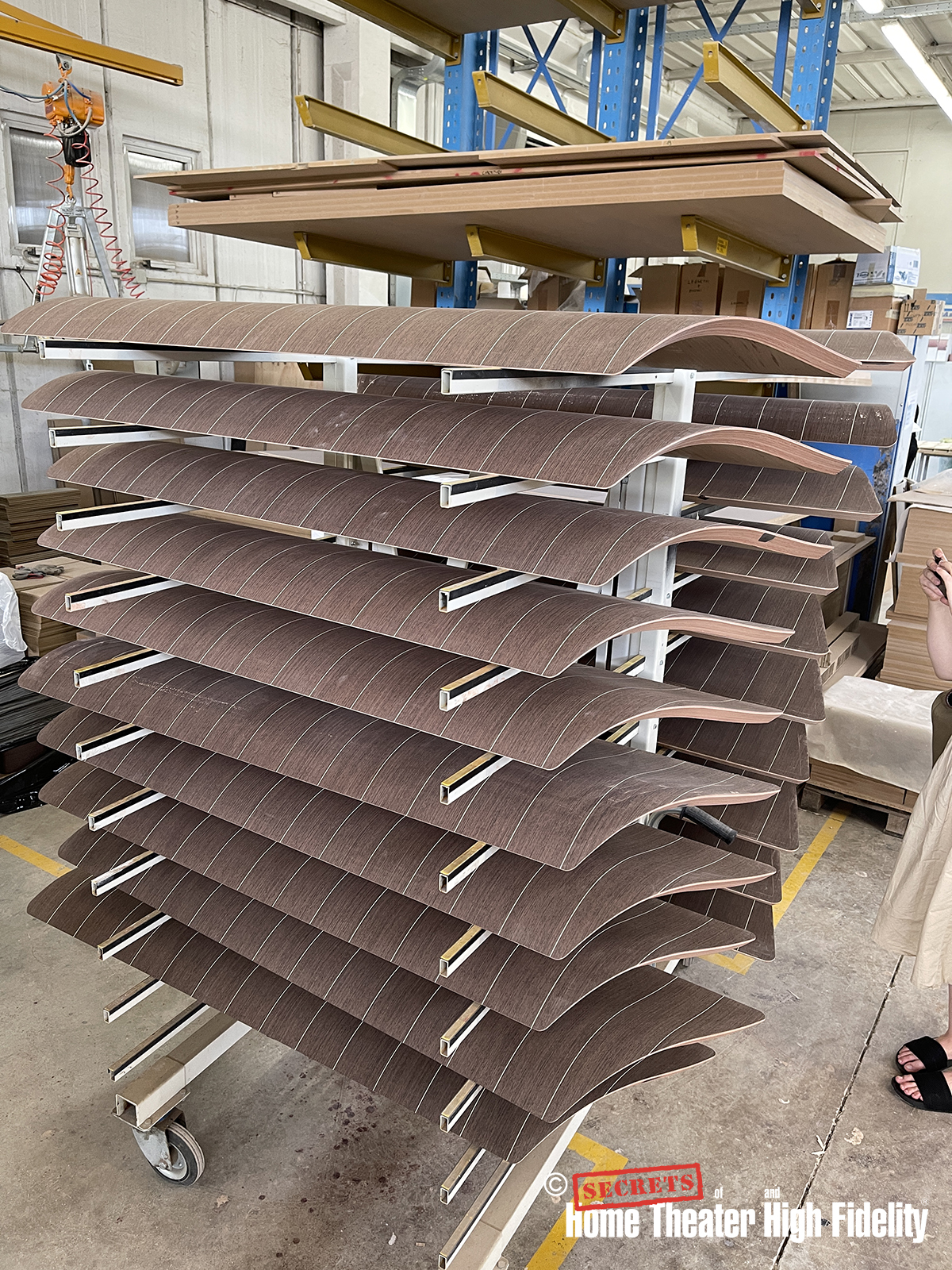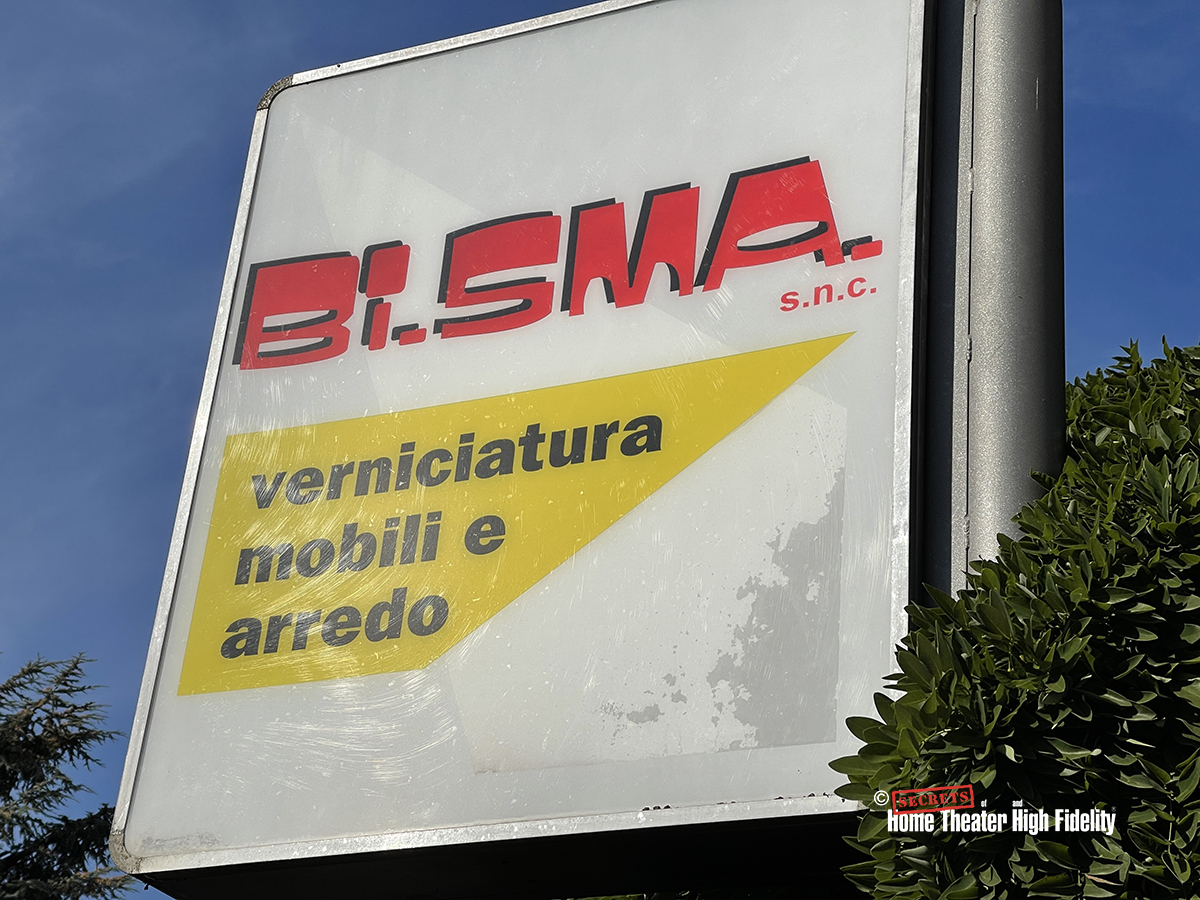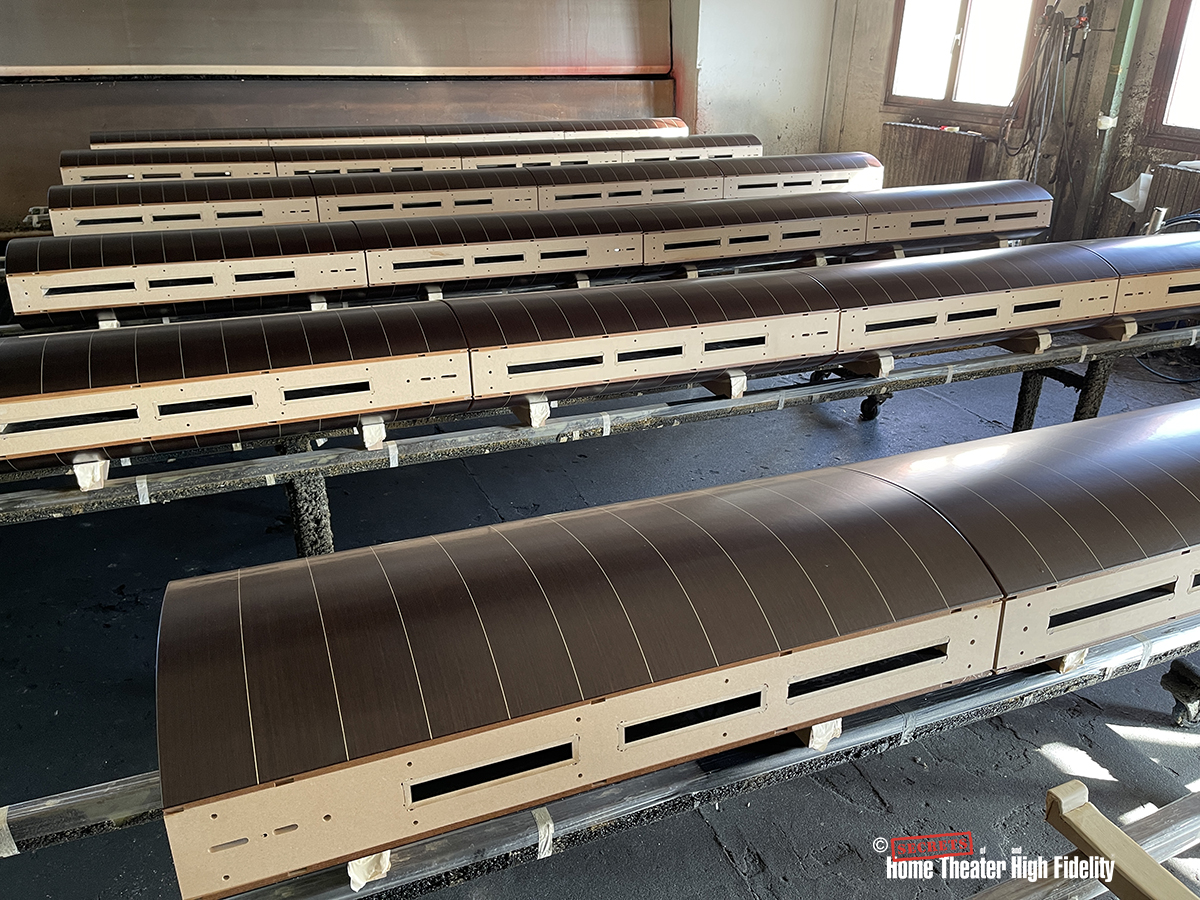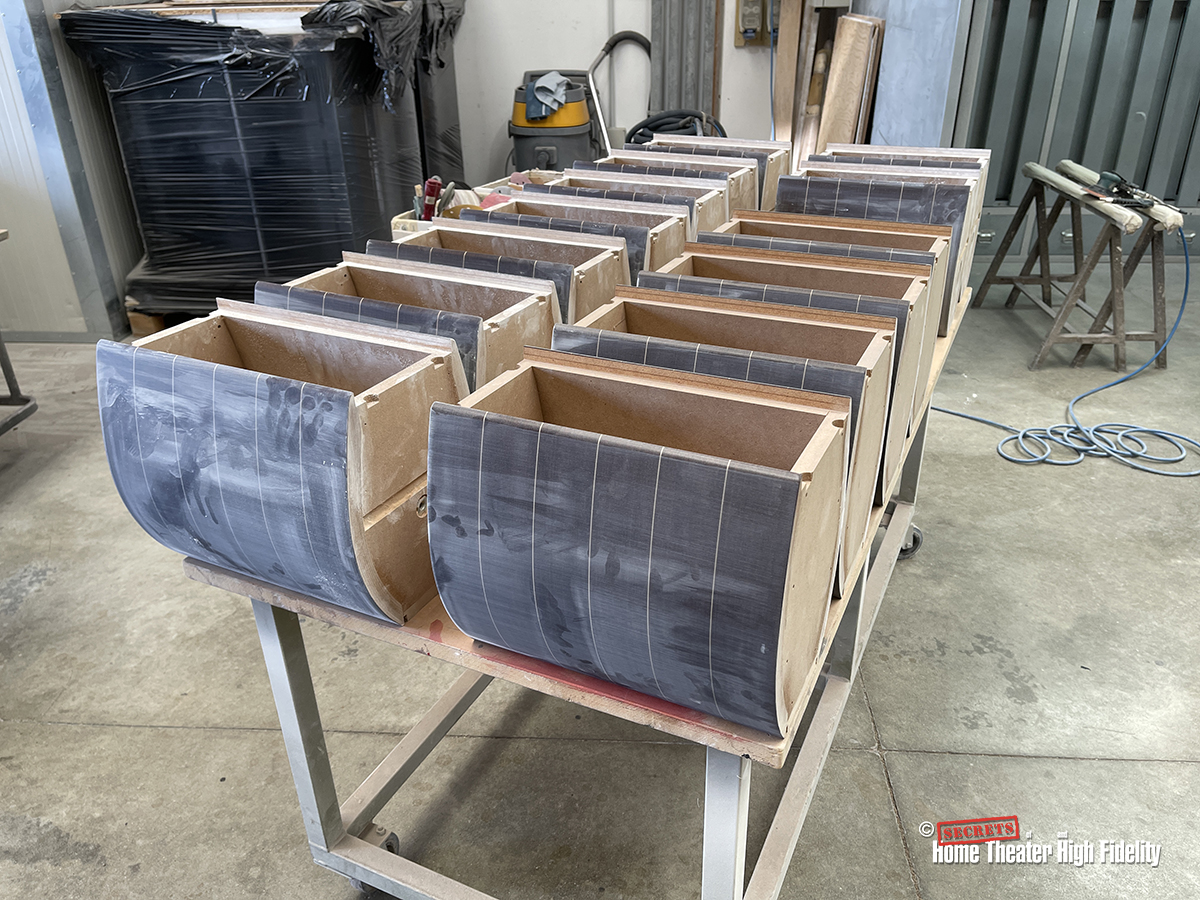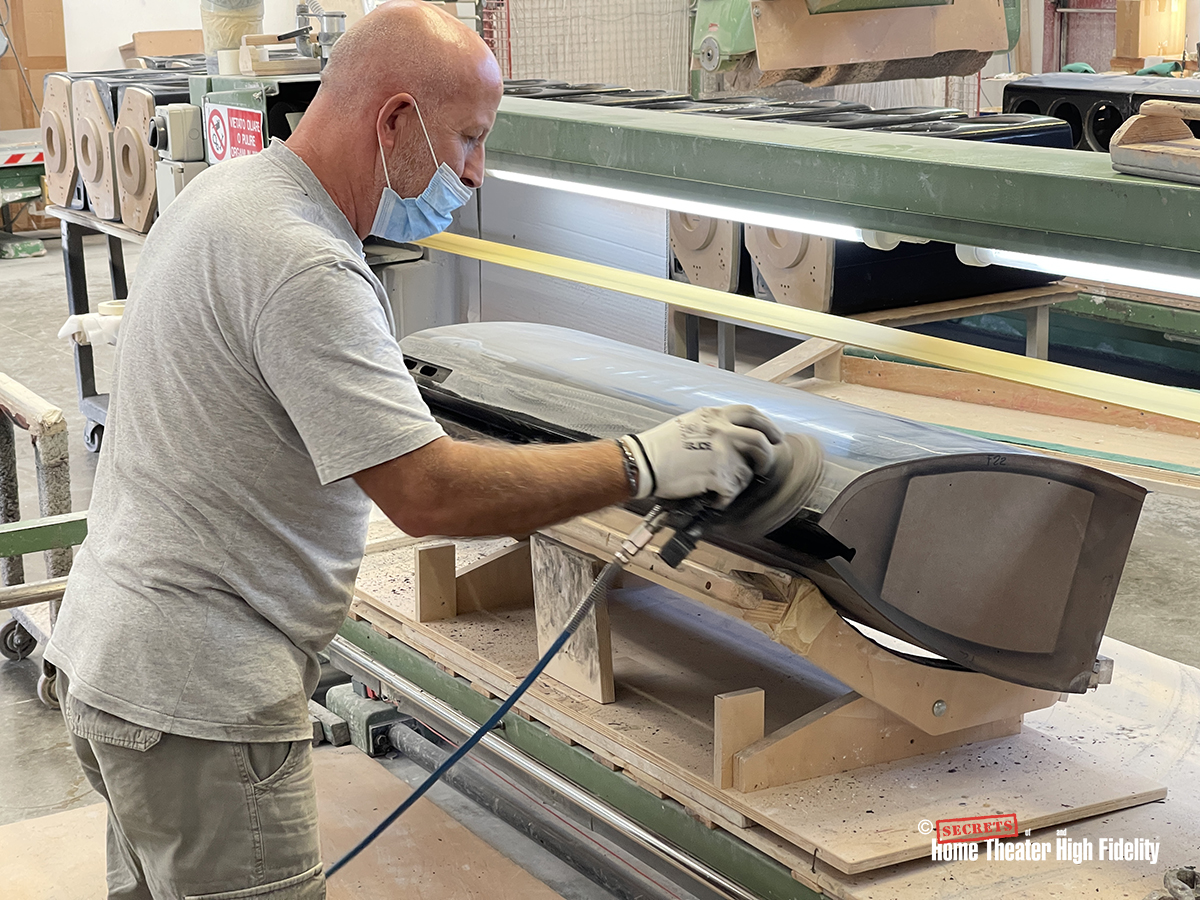Especially when said operations are in Italy. Not unlike a car nut being invited for a peek at how Ferraris or Lamborghinis are made, it’s truly an opportunity not to be missed! In a bizarre twist of fate, I received the invitation for this event just after penning my Op-Ed on the current state of audio shows (https://hometheaterhifi.com/editorial/oped/a-word-about-the-current-state-of-audio-shows/). At that moment in time, I had been slated to go to CEDIA, AXPONA, and RMAF with the Sonus faber trip tentatively falling somewhere in the middle of that. In short order, I would see AXPONA and RMAF get canceled (one of them permanently) over COVID-19 concerns and CEDIA 2021 shrivel to the point of irrelevancy for the same reason. Ironically this left only the trip to Italy as a go. A trip that I was more than happy and willing to take but one that, with four separate plane flights and three packed airports, would put my double-vaccinated status to the ultimate test, more than any of the now-defunct shows might have. I decided that this trip would be a good indicator to me if audio shows and related travel could start happening in a safe way. At this point, I would like to thank the leadership and staff at Sonus faber and the McIntosh Group for putting this trip together. The attention to detail and professionalism in organizing the travel, on-site COVID testing, and general handholding in making sure we had all the appropriate documentation in order were outstanding. Time to brush off my rusty Italian because I was going to be working it hard-core the next few days!
September 28th. After my flights from Columbus, Ohio, to Newark, New Jersey and finally arriving in Milan, my initial concern that international air travel was going to be some difficult and drawn-out affair was put to rest. With COVID test results and country-specific entry form in hand (different forms apply for different European countries), things went smoothly. The biggest challenge was wearing a mask for the lengths of time required on the planes and in the airports. Not something I’d ever want to see become a permanent situation but certainly understandable in the times we are in. My driver, an affable chap named Mattia met me and industry colleague Al Griffin from Sound and Vision outside the arrivals terminal at Malpensa airport and shepherded us on a two-hour drive from Milan to our hotel In Vicenza. We weren’t in Kansas anymore, Toto!
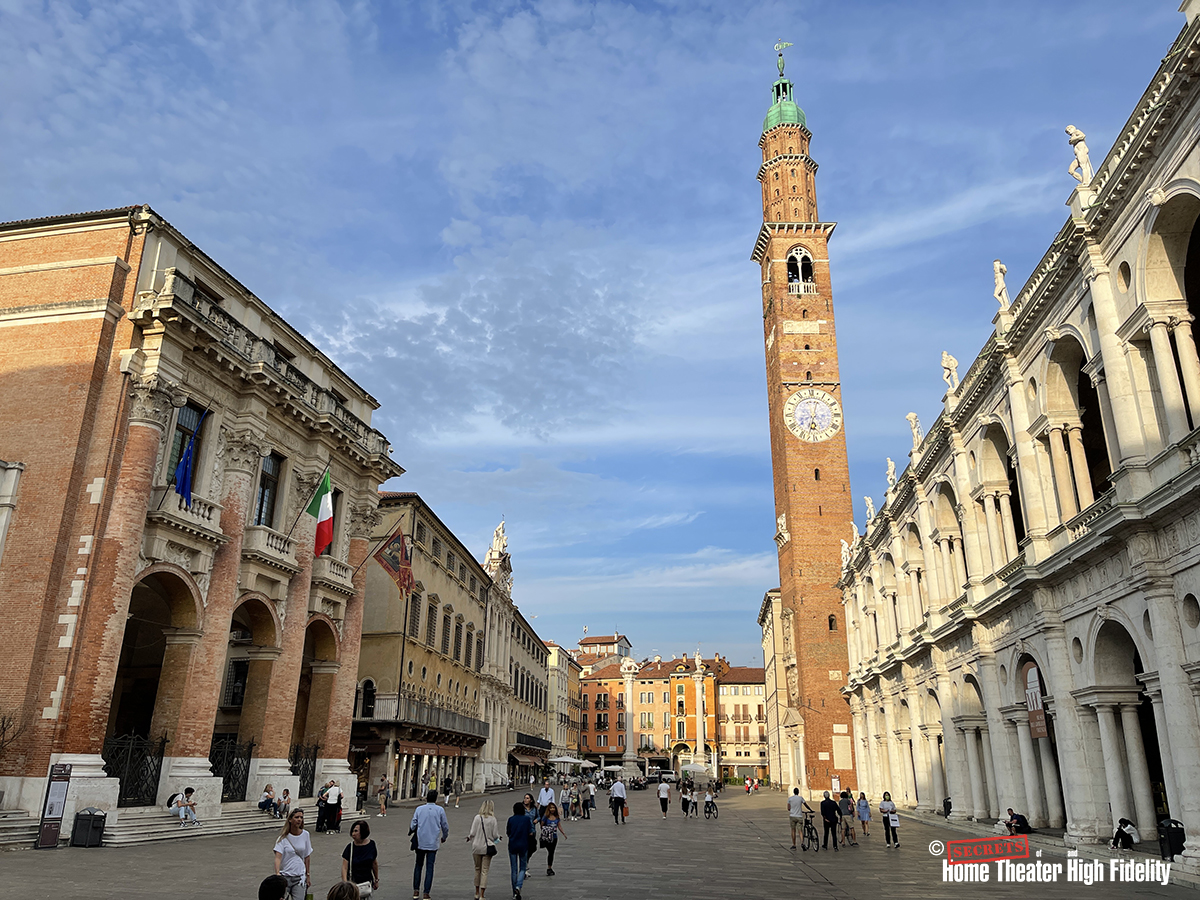
Piazza Dei Signori and the Palladian Basilica.

Cathedral of Saint Mary of the Annunciation, exterior.
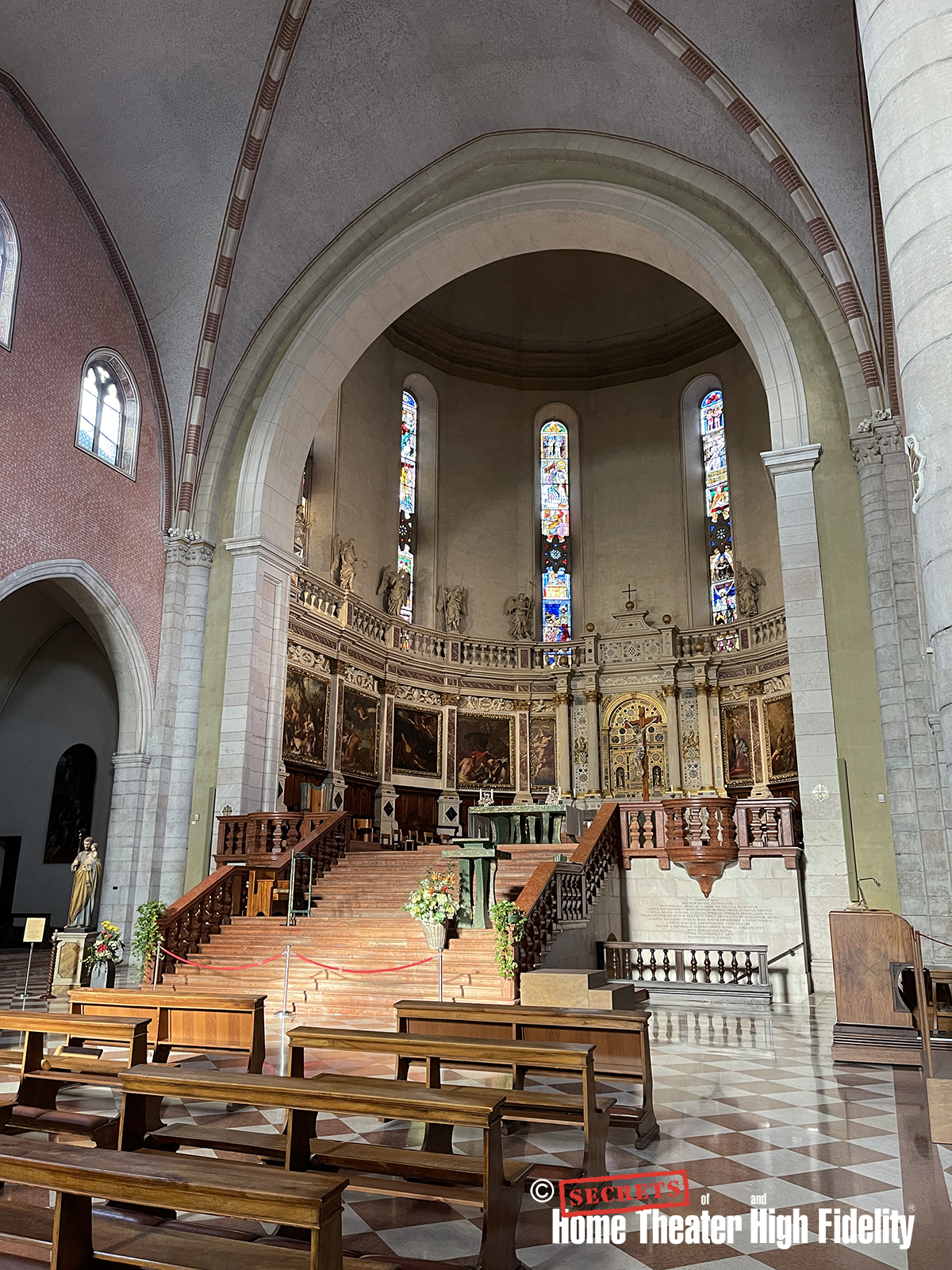
Cathedral of Saint Mary of the Annunciation, interior.
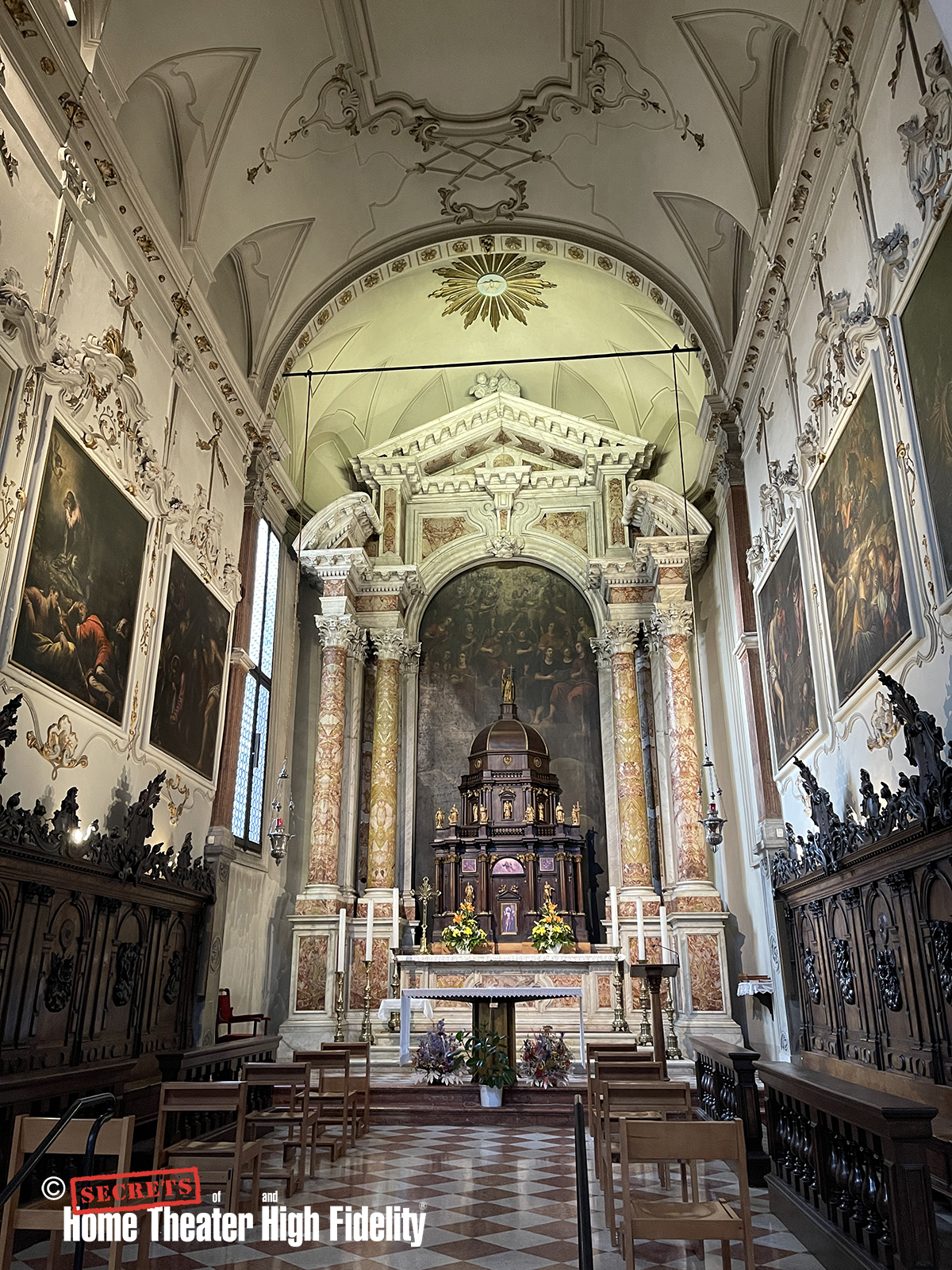
Cathedral of Saint Mary of the Annunciation, interior.
Our hotel was in the historic center of Vicenza where we got to explore several of the old churches and piazzas (town squares). Everything in this area was dripping with old-world charm and history, from the cobblestone streets to seemingly endless archways and statuary. There was also a traditional open-air market with dozens of stalls in the main central square, doing what seemed a brisk business in the early afternoon.
Mixed in with all this history though were many thoroughly modern shops, artisan bakeries, restaurants, and bars. This very much old-world meets new-world sort of vibe was a theme that would repeat itself in the coming days of this trip and beyond at a merely superficial level. We had the afternoon to get settled and we would be attending a dinner that evening to meet and greet everyone and get a sense of what would be happening on the tour starting tomorrow.
September 29th. The next day began with the eight members of our little group (all hi-fi and lifestyle writers/editors) boarding a shuttle bus for a short drive to the main Sonus faber headquarters/production building in the town of Arcugnano. The building itself is a thoroughly modern construct with a scalloped roof design that mimics the shape of a violin when viewed from above. Here we were met by Marta Vecellio (Sonus faber’s perpetually sunny Marketing Manager) who would be our guide for most of the two-day tour.
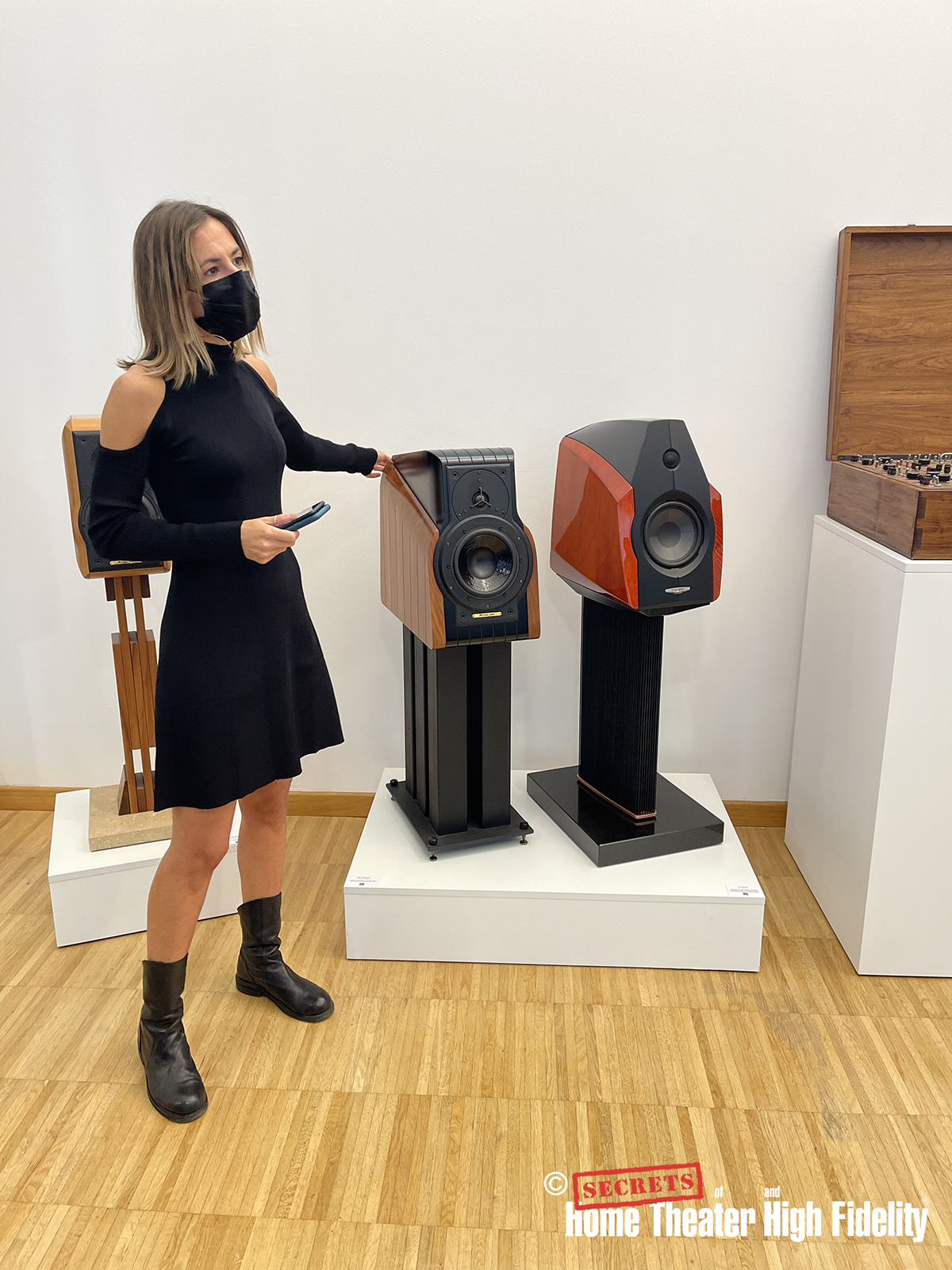
Marta Vecellio Sonus faber’s Marketing Manager.

Marta begins to walk us through Sonus faber’s product history.
Marta began with an introduction to the history of Sonus faber and its founding in 1983 by the late Franco Serblin, an Italian entrepreneur and designer who was passionate both about musical instruments and audio. The building’s lobby area was designed to be almost a mini-museum that showcased several milestones in Sonus faber’s product development, which Marta studiously walked us through.
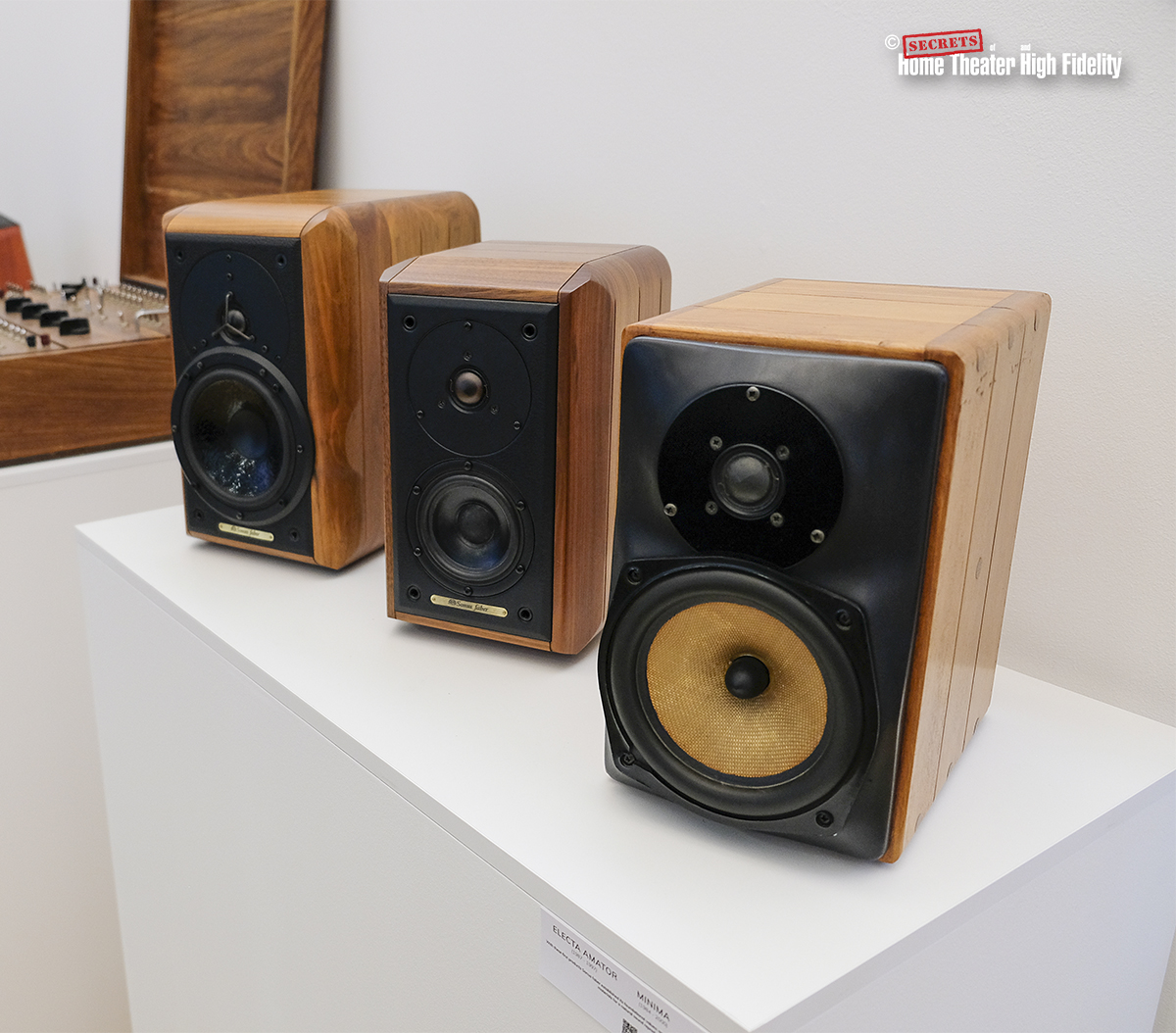
From Right to Left- The Parva, The Minima, and The Electa Amator. Sonus faber’s first three loudspeakers.
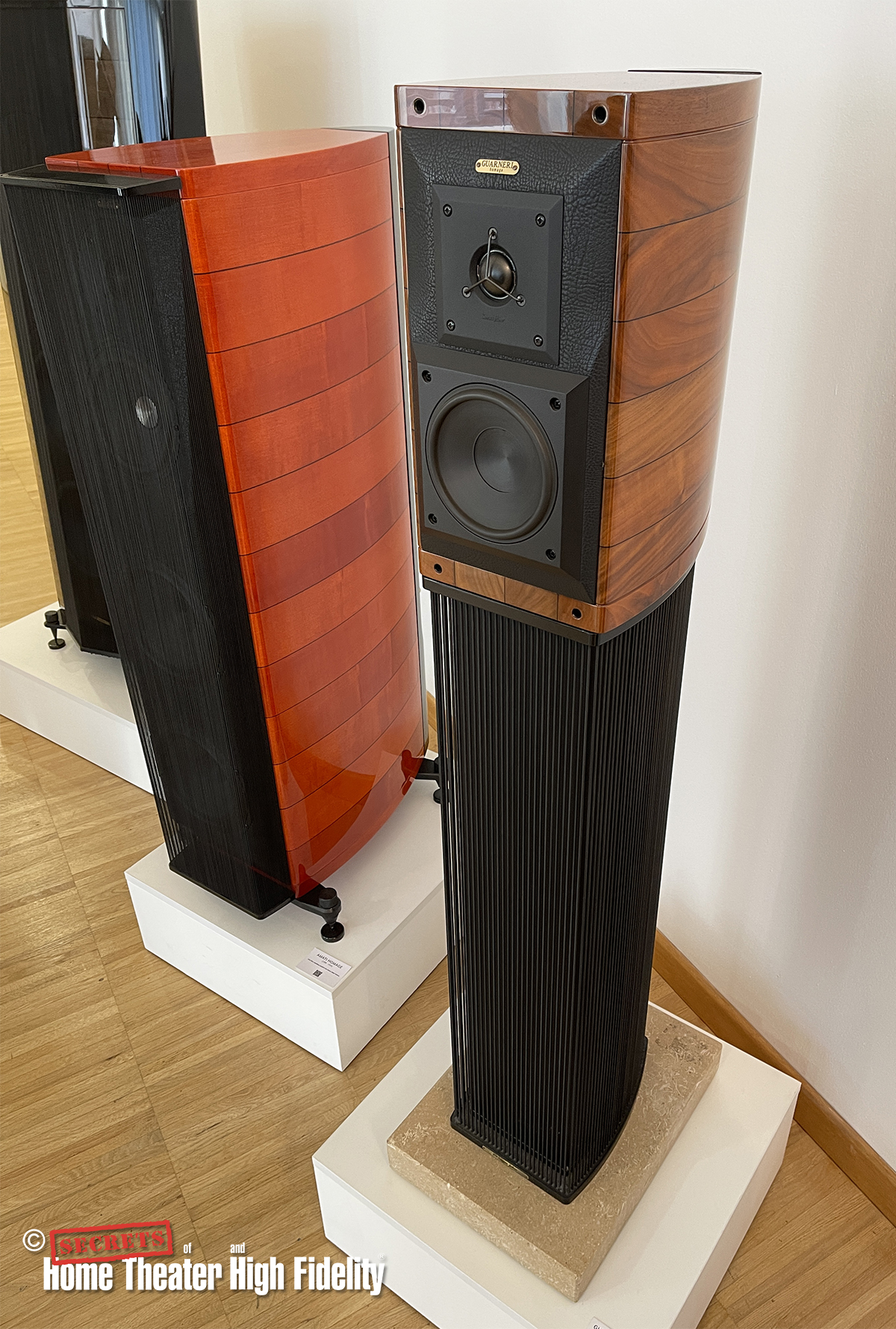
From Right to Left- The Guarneri Homage, and The Amati Homage.
Marta began with the earliest speakers, the Sonus faber Parva, Minima, and Electa Amator from the 1980s (all two-way bookshelf designs) through 1993’s Guarneri Homage (the first Sf speaker exploring the lute design motif) and 1998’s Amati Homage (Sonus faber’s first production three-way speaker). She then walked us through some even more ambitious floor-standing designs such as the Stradivari from 2004, 2015’s Il Cremonese, and the towering Aida from 2017, to touch on just a few. Examining each of these display examples closely, one cannot help but be impressed at the level of handcraftsmanship and respect for the natural materials used in the creation of these speakers. It certainly made for a beautiful history and body of work.
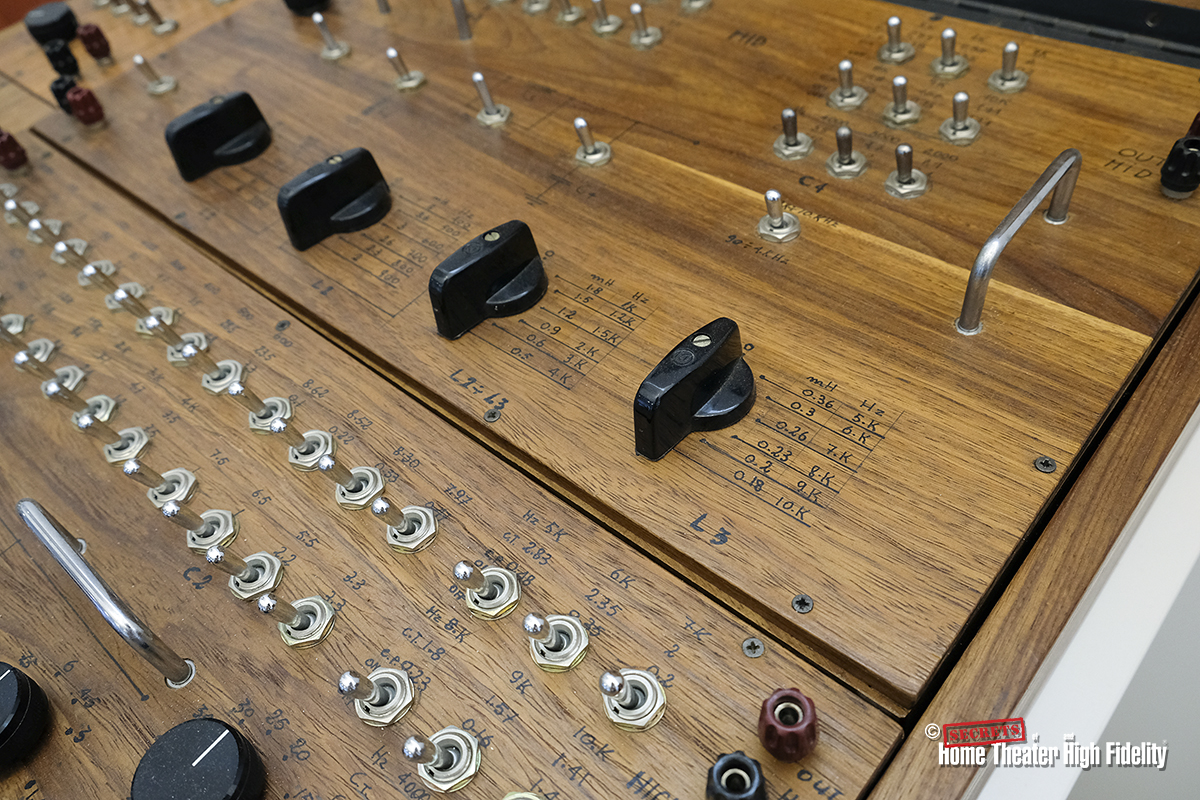
Handmade Crossover Tester- Close up.
And yet, the one thing that honestly blew my mind most of all about this display was not even a speaker. It was a large, handmade crossover tester whose casework was completely made of solid walnut with hand-etched names and values at all the switches and knobs. Made in 1984, this analysis tool, that anyone else would probably have encased in a standard workaday plastic or metal box, was built and finished to the standard of fine heirloom furniture. Looking like something out of an early James Bond movie, it struck me as the sort of absurdly beautiful object one builds if they are equal parts passionate, obsessive, and more than just slightly mad.
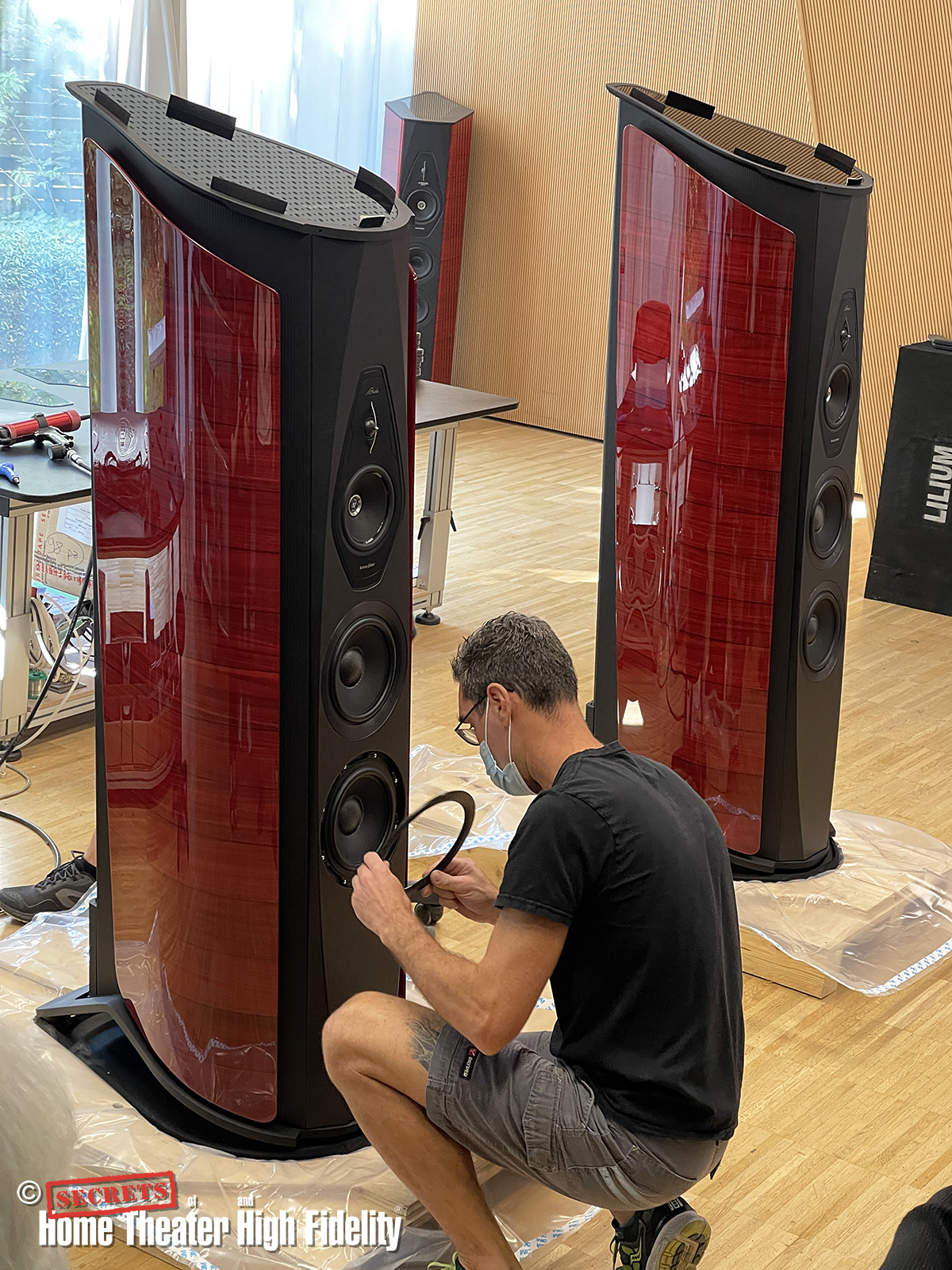
Sonus faber Aida, Final Assembly.
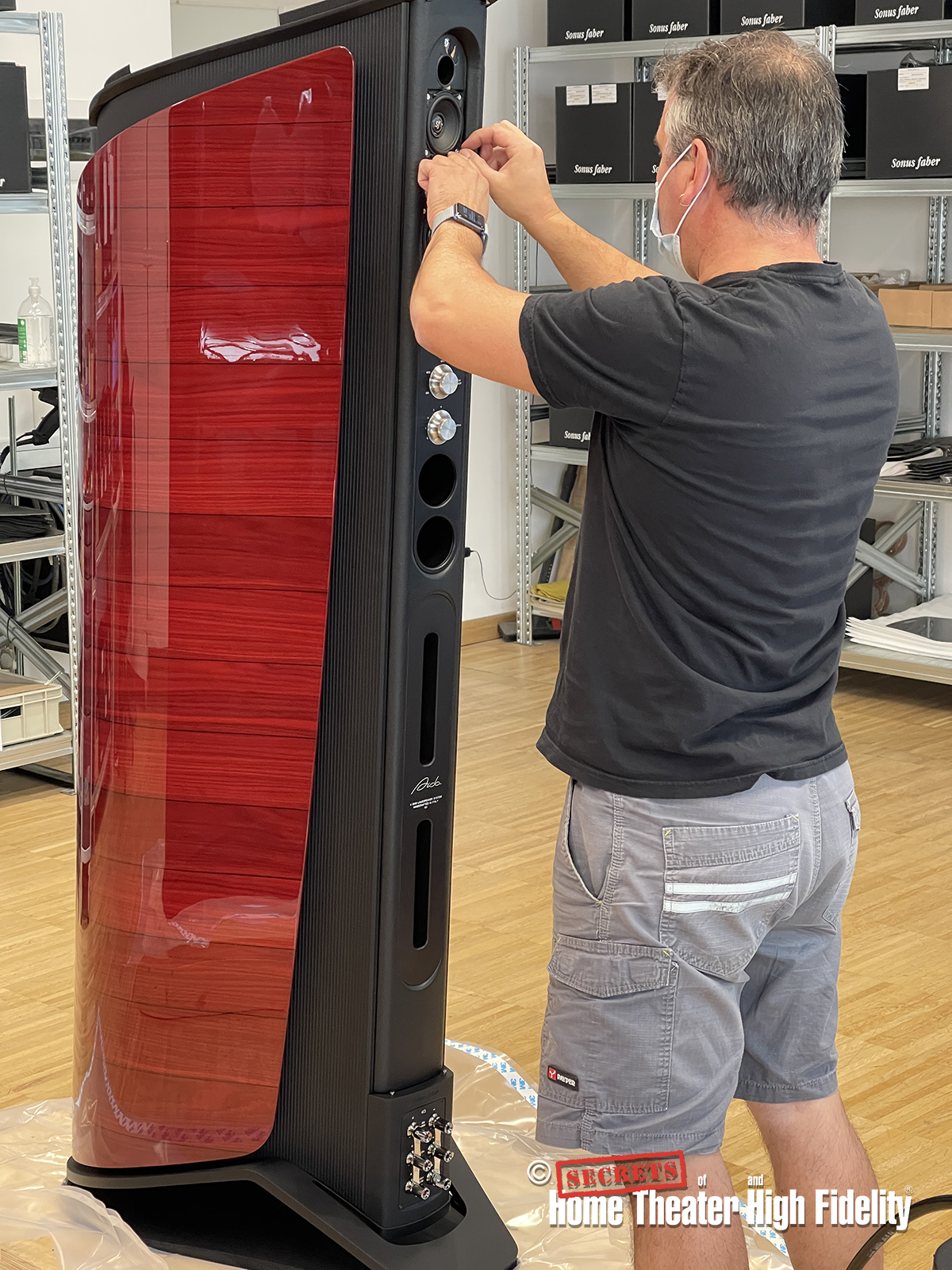
Sonus faber Aida, Final Assembly.
Next, Marta escorted us to a segregated area of the assembly floor known as the Production Boutique. This large room is reserved exclusively for the assembly of Sonus faber’s Reference collection loudspeakers. The room was clean and modern-looking with hardwood flooring and floor-to-ceiling windows that let in plenty of natural light. Take the workbenches and organized parts shelves out of there and it could easily double as someone’s living room with the right furnishings. During our visit, we witnessed three craftsmen carefully putting the finishing touches on a gorgeous pair of Aida loudspeakers in a stunning fiery red finish. “The Queen,” as these speakers are known internally roughly cost about $140,000 US dollars for the pair and it was plain to see the meticulous care and attention to detail that the artisans were exhibiting in this final assembly stage. If I were the lucky future owner of these speakers, this sort of insider experience at seeing my speakers come to life would be the kind of thing I would completely geek out over!
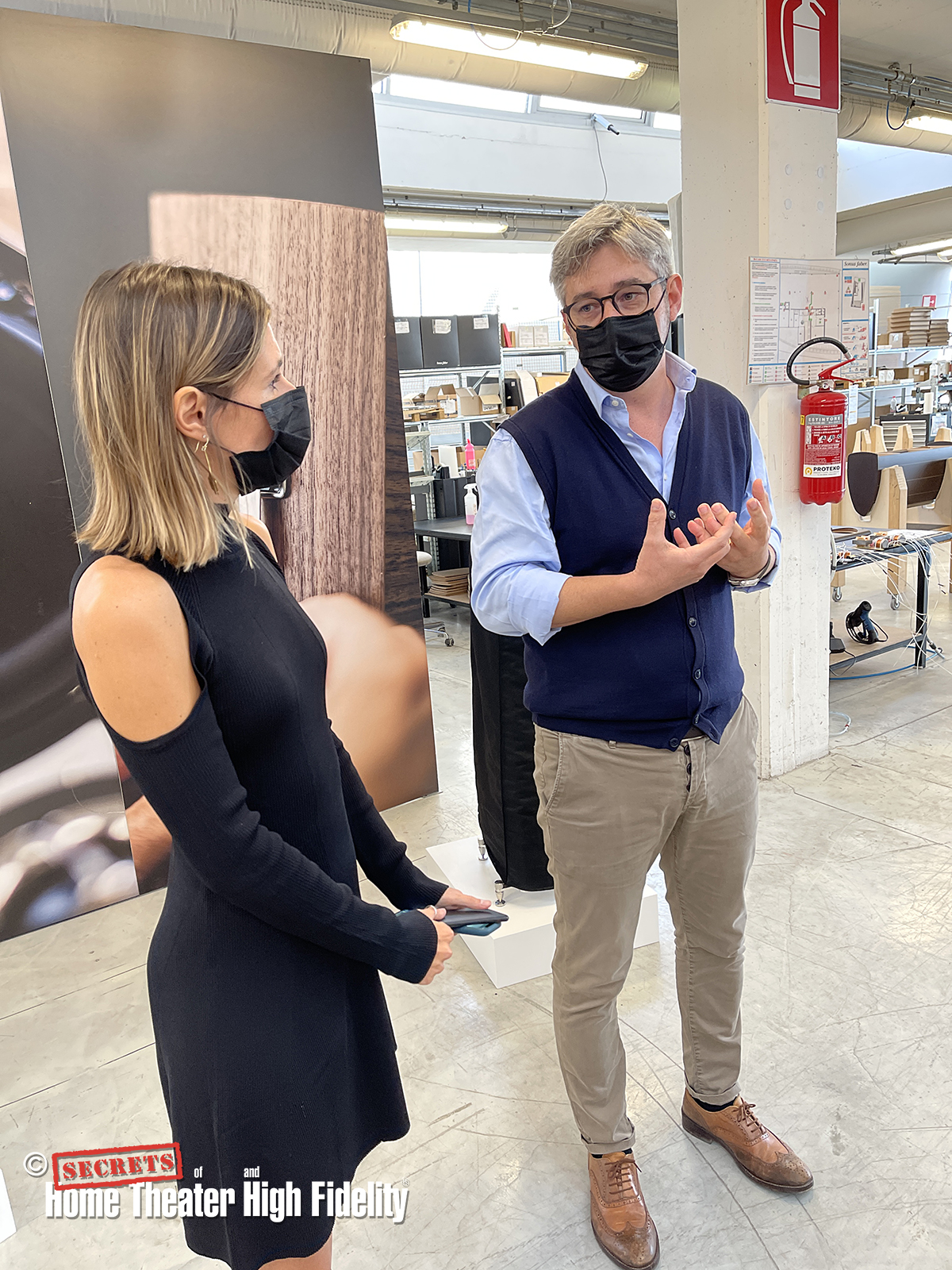
Simone Farinello, Sonus faber Production & Operations Manager.
Moving from the Boutique area, our group was brought into the main Production and Assembly floor where the bulk of Sonus faber’s products come into being. Marta introduced us to Simone Farinello, Sf’s Production & Operations Manager. Simone has been with the company for 26 years and it was clear from listening to his explanation of the various activities that happen on this floor, his deep affection for both the brand and the art of what he and his staff of 24 craftspeople do here.

Inspecting Lumina I Front Baffles.
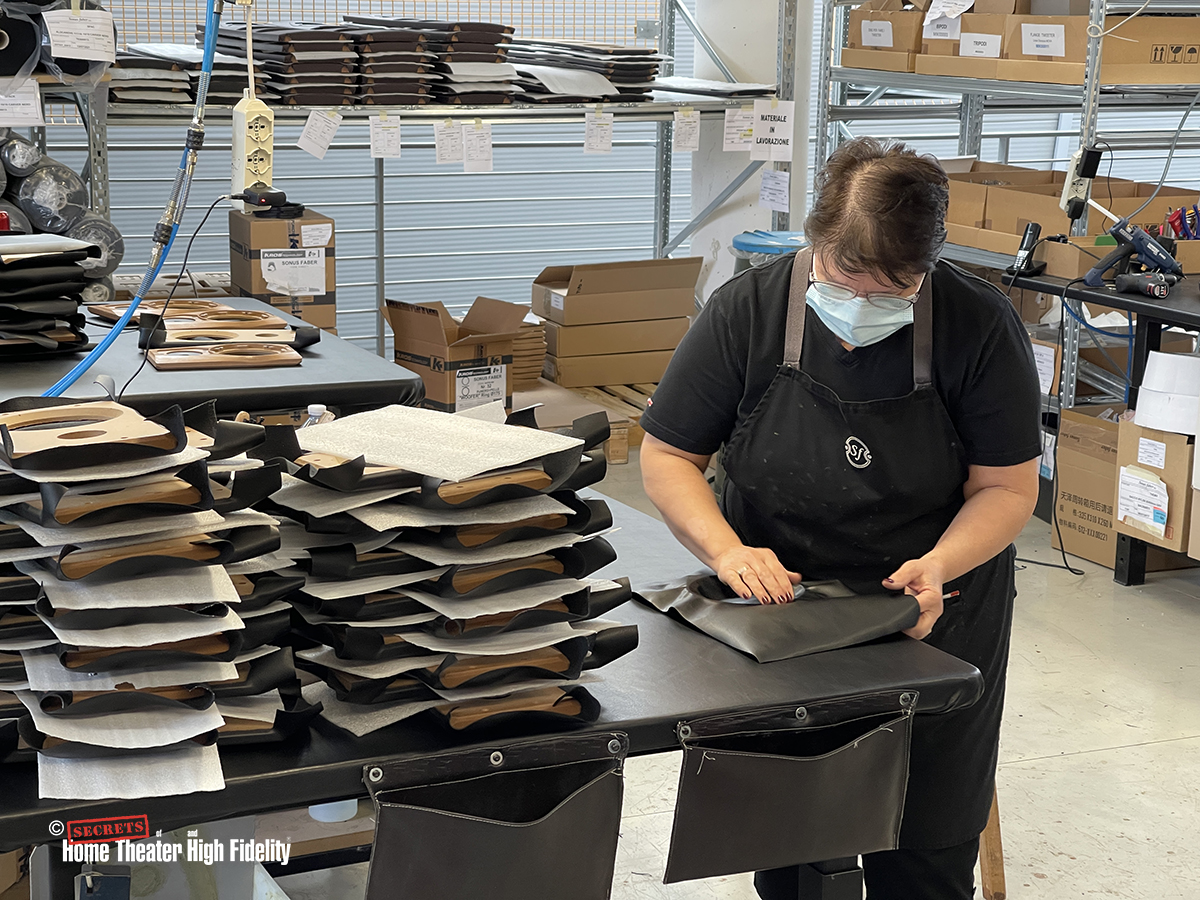
Stretching and Trimming Leather Accents.
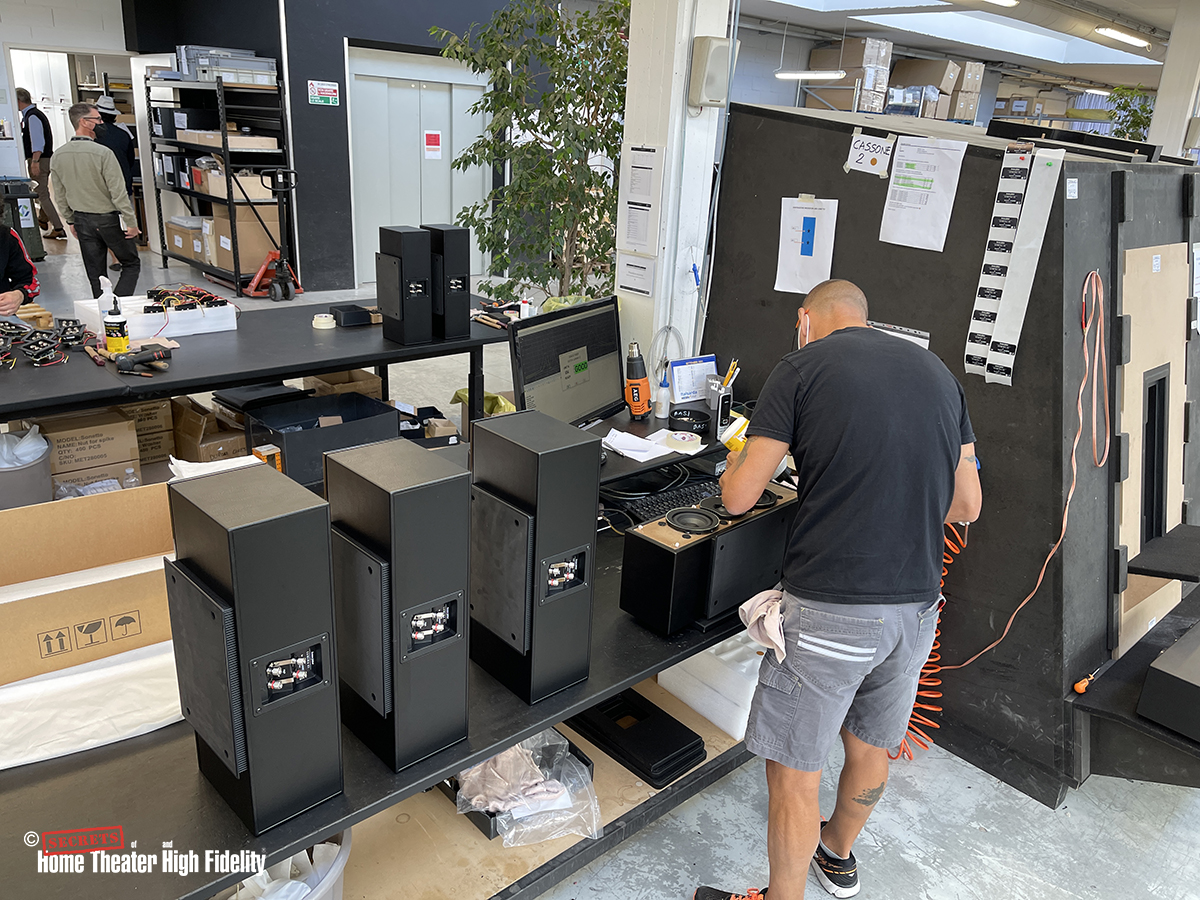
Installing Front Baffles on Lumina CI.
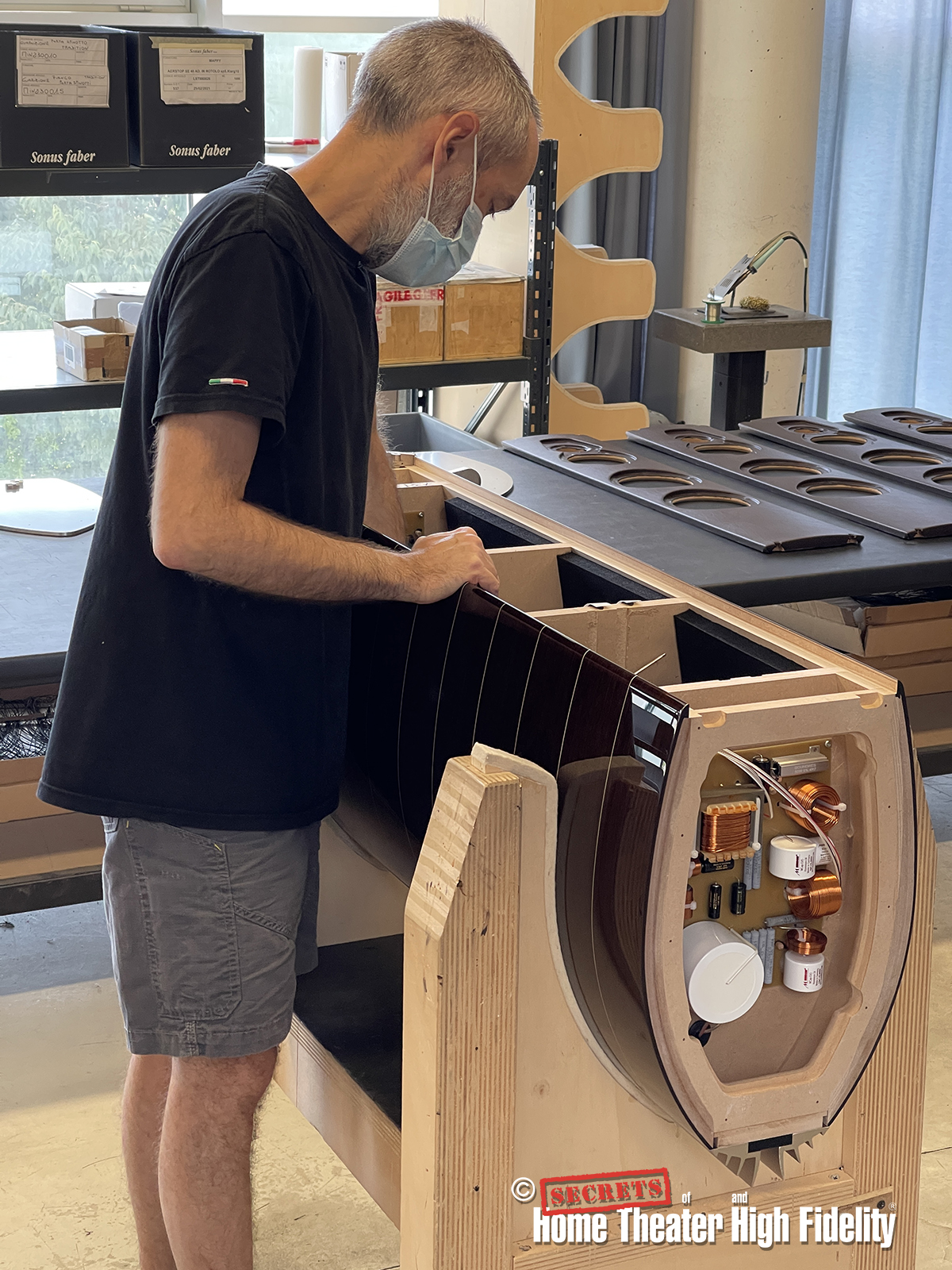
Loading Components into a Serafino Loudspeaker.

Table full of Electa Amator III Speakers.
Simone walks the floor with us introducing us to various staff and outlining what each person is doing. Everything from trimming and wrapping leather to assembling and loading crossovers to installing drivers and damping material to final assembly was actively being done here. Today we see craftspeople working on various Lumina models (Sf’s most affordable tier that is almost entirely made in Italy), several Serafino and Vox speakers from the Homage Tradition collection, and a table loaded with several pairs of the beautiful little Electa Amator III speakers replete with their jewel-like crossovers, lovely solid American Walnut cabinets, and Carerra marble baseplates.
Speaking of crossovers, the company sources its crossover components from global vendors that build the key parts to Sonus faber’s specifications. Custom-made capacitors from ClarityCap and Mundorf are one such example. As the Italian sense of heritage and pride runs deep in the company’s veins, Sonus faber will always look to see if an Italian vendor for any component is available that meets the rigorous standards they expect.
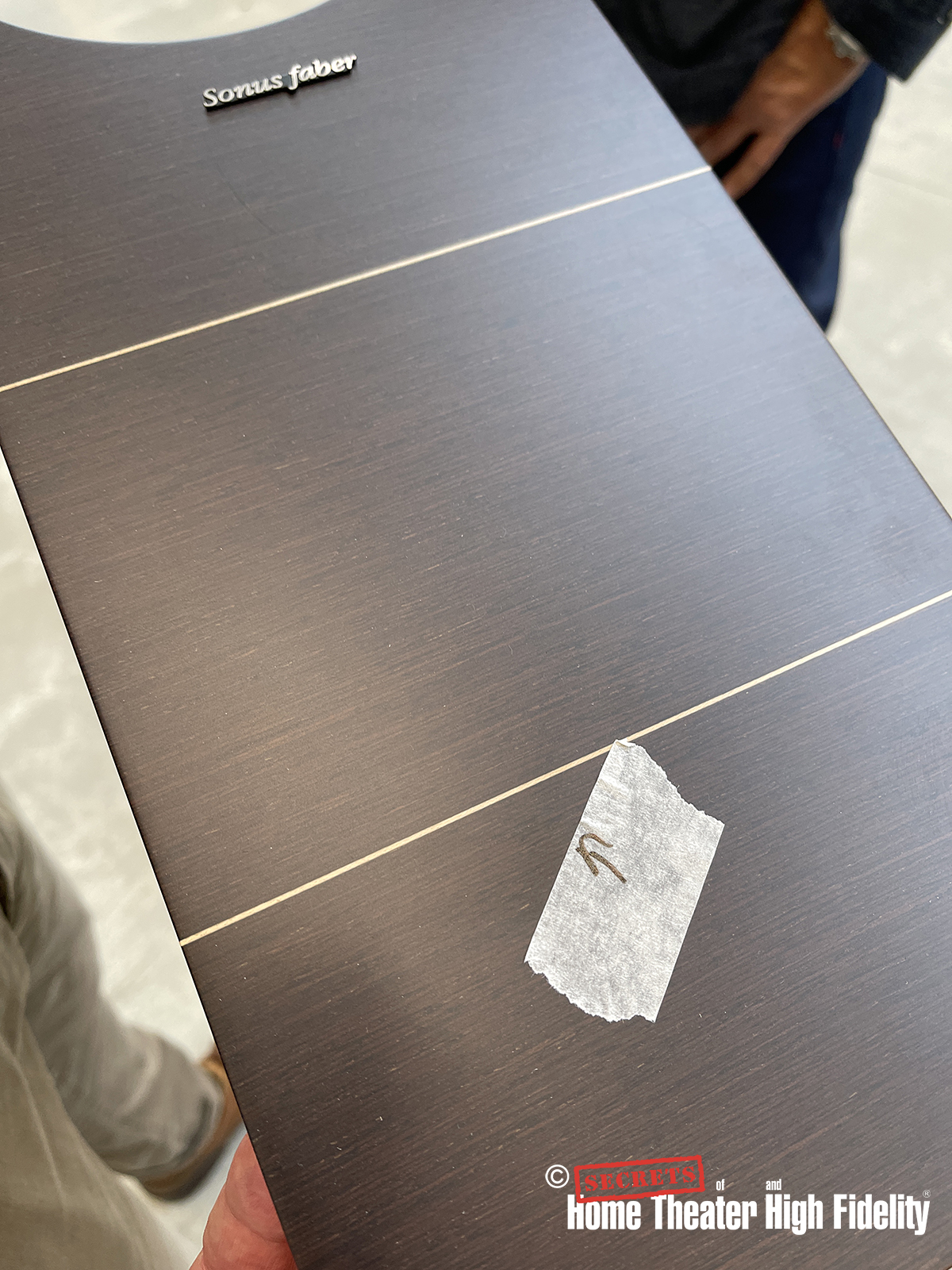
Lumina III Baffle QC reject, Close Up.
Simone explains to us that while final assembly, testing, and quality control is done here, the cabinets are built and finished at one of two outside woodworking facilities that Sonus faber contracts with (we will be visiting both tomorrow), and then they are transported here for him and his people to complete. Speaking of quality control, he pulls out what looks like a Lumina III front baffle panel, in Wenge, from a short stack of “rejects” to show us. It has two masking tape strips with arrows drawn that point to the offending blemishes that deem the panel not currently usable. Looking it over we were all honestly straining to see these supposed imperfections in the finish. I had to practically put my nose to the panel to find what Simone was talking about. The point here is that the finishing checks are rigorous. Any panel, trim, or cabinet flagged at this stage will be sent back to the woodworking shops to salvage and restore.
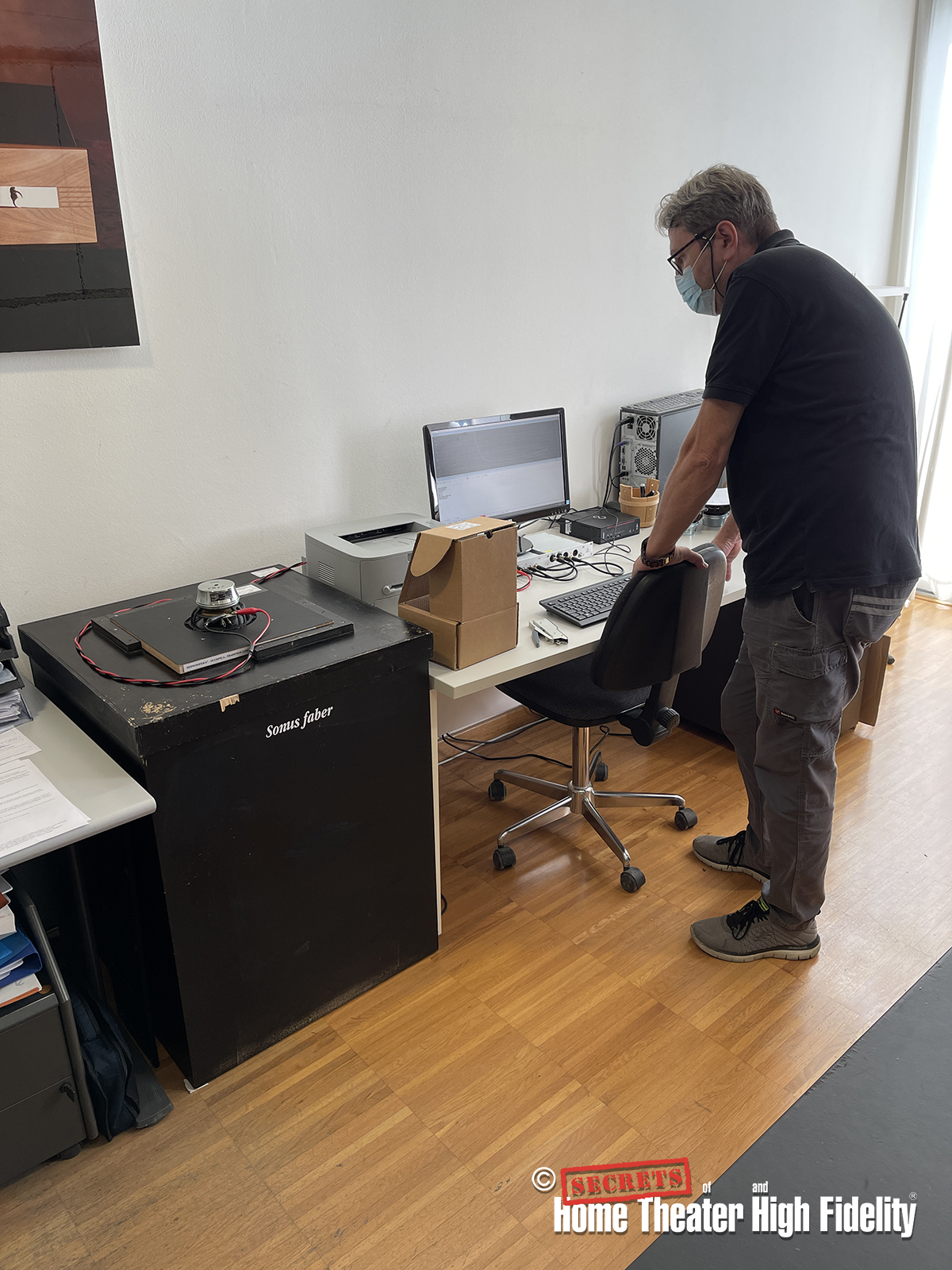
Technician QC Testing a Driver.

Everything is Documented down to The Last Detail.
Secrets Sponsor
We are then taken to the component testing area where we see a technician stress testing individual drivers using a computer and a special driver testing rig. Pretty much every driver and component is tested in some way to make sure that it meets the performance targets. It’s a time-consuming process but it is much easier to catch a flaw at this stage than after everything is assembled and at final testing. Also in this room is what amounts to a speaker archive, comprised of binders of material outlining how every current model of Sonus faber loudspeaker is put together, down to the smallest part. It’s like a set of How-To encyclopedias that are regularly referenced and are a necessity for training. The one thing Simone does lament is that (like on this side of the pond) it’s difficult to find the sort of young, willing, and interested talent that they need to comprise the next generation of builders to keep up with the demand for Sonus faber’s products. That, along with the global supply chain issues, have been the two most pressing difficulties that the company has had to work with.

Serafinos Waiting for Parts for Final Completion.
He points to a pallet of a dozen Serafino loudspeakers that have been built to as far a stage as possible and they now are simply waiting for the missing parts to complete their construction. He calmly states that every speaker that we see on this floor is spoken for by either a customer or dealer. There is no excess capacity now. Simone estimates that if at least the supply chain was normal, the company could almost double its output, demand being so high.

Sonus faber Design Lab sign. That’s all we can show you!
After a splendid Italian lunch (I mean c’mon, we’re in Italy and how could it be anything but?), Marta brought our little group across the street to what at first blush was an outwardly unremarkable building. But inside was housed what amounts to the company’s personal “Skunk Works” unit, the Sonus faber Design Lab. This is the place, for example, where the Lumina line was created, not out of market necessity but because they wanted to know if it was possible. The Maxima Amator was also cooked up from the fruitful minds here as almost a side project due to sudden additional “free time” brought on by the pandemic. Due to the sensitive nature of the work done here, our group was politely asked not to take photos of the creative area. What I can describe to you in broad terms is that, as someone with an art background, I instantly felt quite at home in this large open-concept space. The area is shared by designers, 3D artists, and marketing folks but there are no departmental silos here.
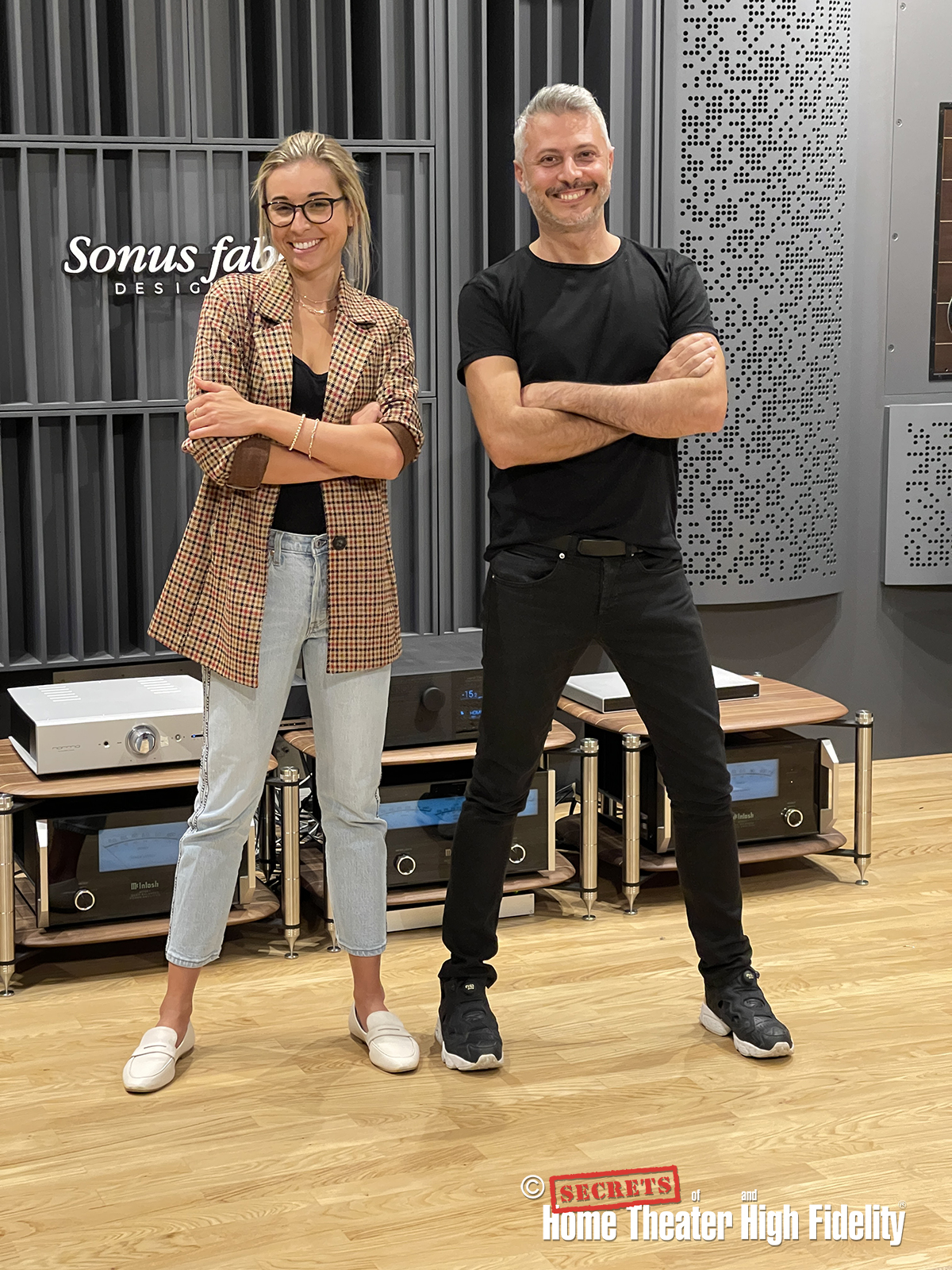
Vice President of Research, Design and Product Development, Livio Cucuzza hamming it up with McIntosh Group PR Manager Extraordinaire, Julia Lescarbeau.
Livio Cucuzza, the Vice President of Research, Design, and Product Development
emphasized that there is a sense of open camaraderie and creativity amongst all of them. Ideas from everyone are freely encouraged and explored and while they do much of their prototyping and exploration using 3D computer modeling, I was excited to see old-school mood boards covered with pencil sketches, napkin doodles, and photographic inspiration all over the walls. Livio explained to us that as a rule of thumb, Sonus faber designs are informed by what the designers see in the natural world. These inspirations can be both from something that occurs organically in nature or natural elements that have been artfully worked by human hands. That’s the visual part of the Sonus faber DNA. And while I can’t expressly tell you or show you what they were working on, I can say that some very interesting ideas are percolating in that building! Towards the back of the space, Livio showed us a medium-sized testing area complete with an anechoic chamber for putting test mules through their paces and exploring if the concepts they are working on are sound. The front of the building houses one of two recently completed listening rooms at Sonus faber. Both rooms can be configured for 2-channel or surround sound listening. The room at the Design Lab is called “The Grey Room” while the other in the main building is “The Blue Room.” Both rooms were built with the assistance of RPG Acoustics and are treated with a higher percentage of diffusion over absorption.
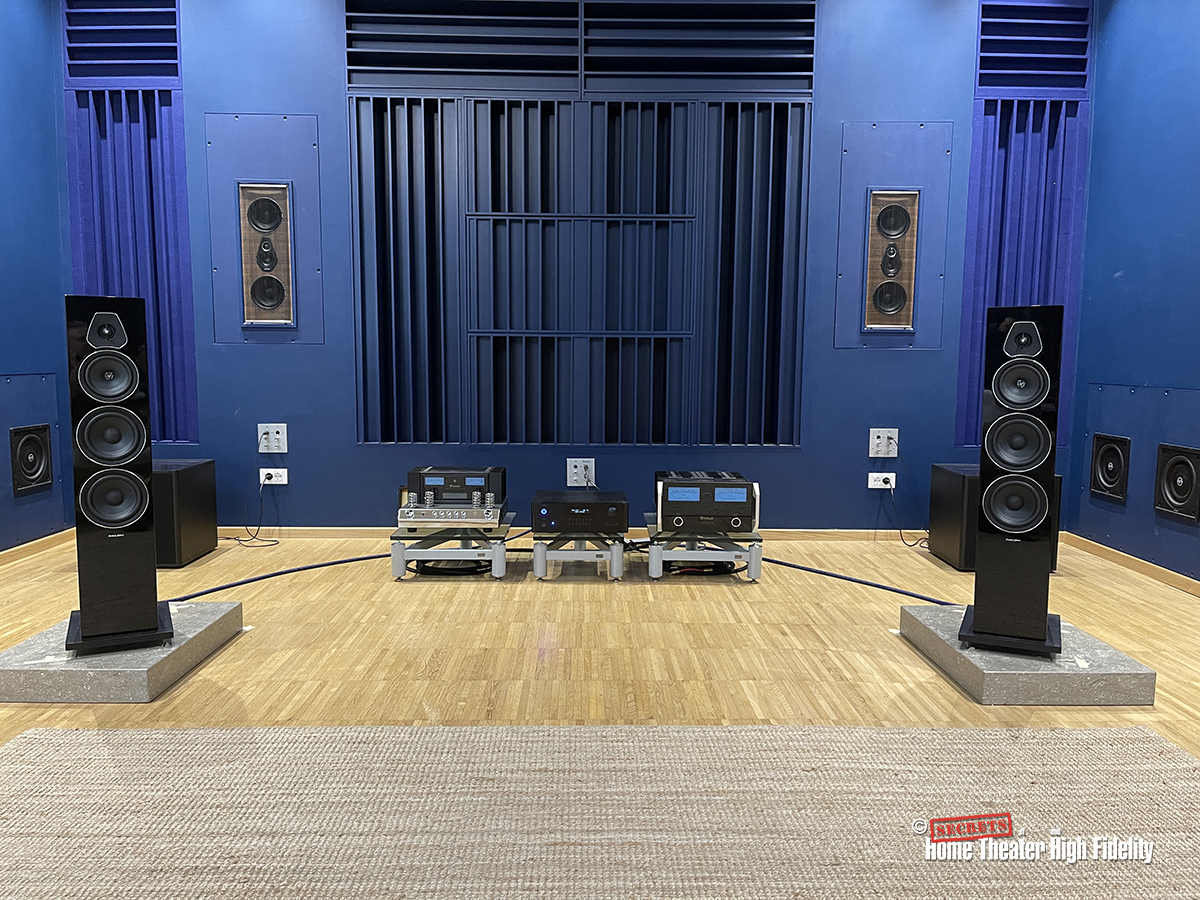
The Blue Room with the Sonus faber Lumina V.

Paolo Tezzon, Sonus faber Brand Ambassador.
It was time for our first listening session in “The Blue Room” so back across the street we went where we were met by Paolo Tezzon, Sonus faber Brand Ambassador. Paolo had prepared a pair of Lumina V tower speakers for us to sample. I had spoken with Paolo the previous evening and mentioned that while I had reviewed Sonus faber speakers in my own home before, my room is far from ideal. So, I was looking forward to hearing what they sounded like in a more “perfected environment.” The speakers were set up well into the room, raised about 6-inches on solid stone bases, and toed in so the tweeters converged right at the listening position. I had previously reviewed the Sonus faber Lumina III and while impressive, I felt that they were a little light on the bass for my taste. Tyler Stripko had a turn at reviewing the Lumina V and noted a stronger bass foundation from the bigger cabinet and bass drivers. I wasn’t expecting an impressive bass response from these speakers, positioned so far into the room as they were, but I was pleasantly surprised at how low and solid the Lumina V sounded in here. Beyond the excellent bass performance, I felt that the Lumina V imaged precisely and threw a big and bold soundscape with the music selections that Paolo had chosen. Saint-Saens’s “Danse Macabre” sounded particularly dynamic with spatially well-defined instrument sections and a great sense of air. I don’t particularly care for Leonard Cohen but the track “You Want It Darker” displayed a palpable sense of weight and texture to Cohen’s almost guttural vocal rendition. Very moody and omnipotent sounding; you felt it in your chest a bit.
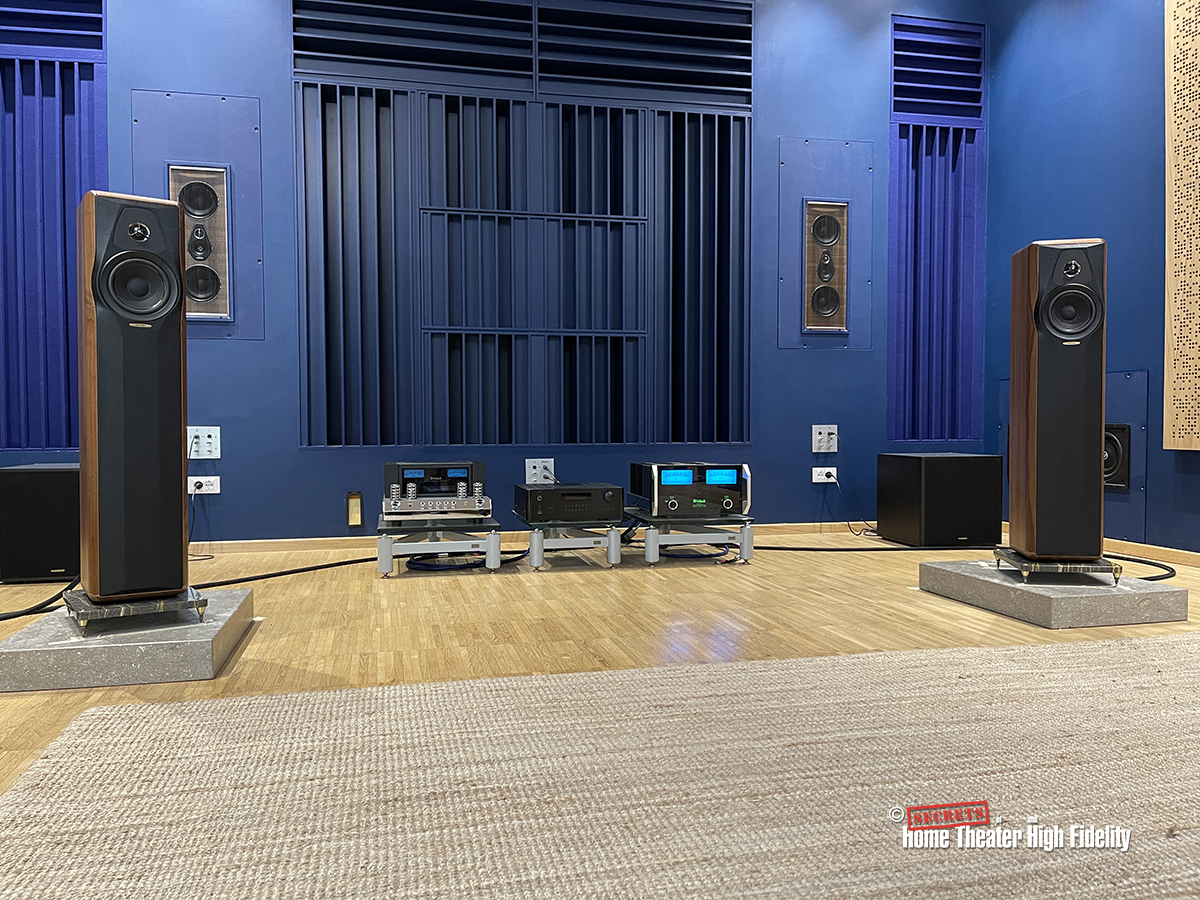
The Blue Room with the Sonus faber Maxima Amator.
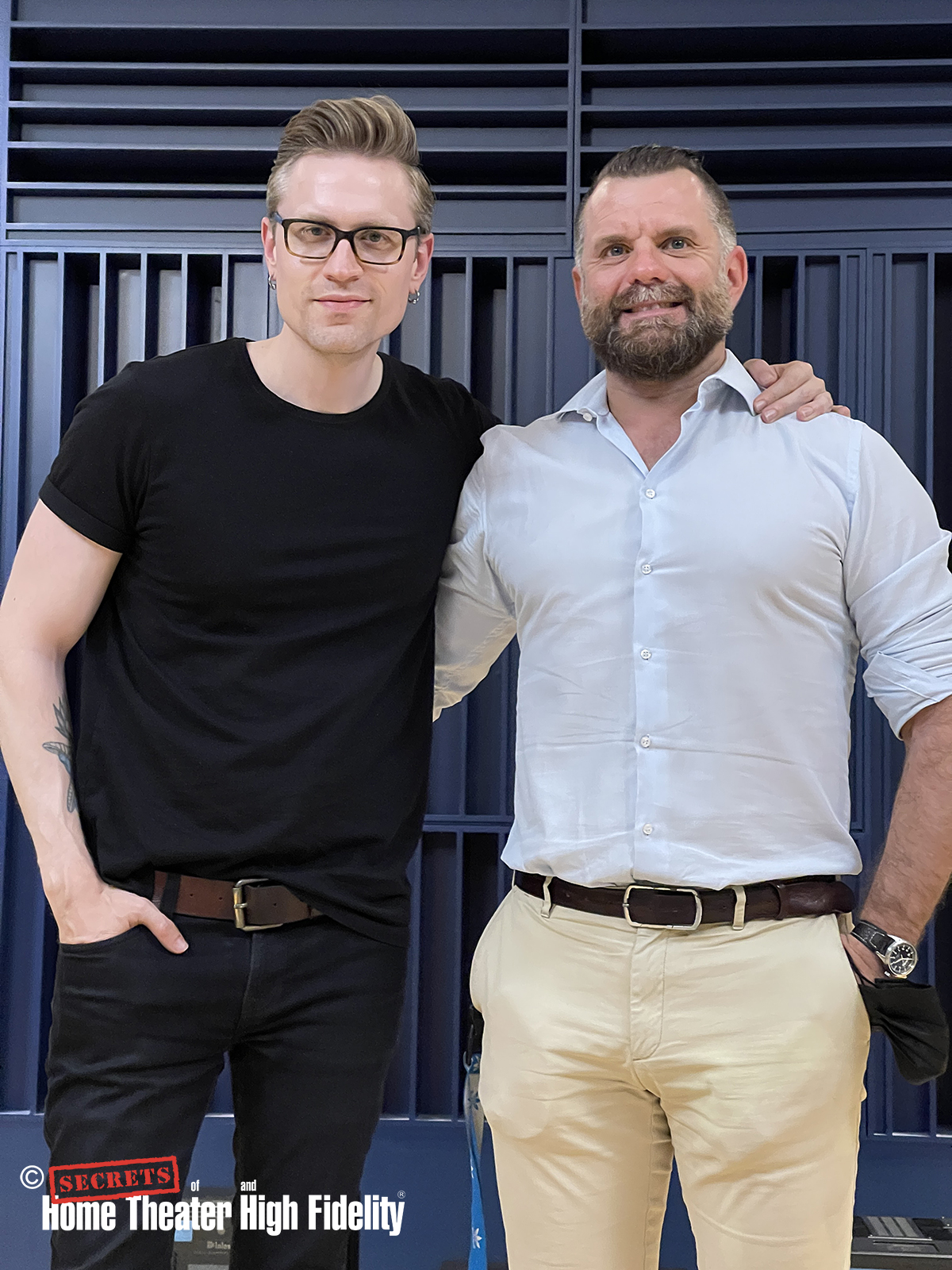
Joshua Dellinger, Experience Director at World of McIntosh with Paolo Tezzon, Sonus faber Brand Ambassador.
We stepped out of the room while the speakers were swapped out and when we returned, we were greeted by a lovely pair of Maxima Amator speakers. It’s obvious by the way Paolo talks to us about these speakers that they hold a special place in the product line. After all, when Sonus faber started, they only built two-way speakers for a good long time. The Maxima Amator is extra special because they are the company’s first tower speakers made with solid walnut cabinets. The wood being an integral part of the speaker’s sonic signature, much like it would be in a violin or a guitar. Replaying the same tracks we heard with the Lumina on the Maxima Amator revealed the expected leaner bass response when moving from a three-way to a two-way design. But it also revealed where the Maxima excelled and that was an overall smoother and more beguiling tonal character in the mids and treble. Imaging on “Danse Macabre” remained incredibly good. A very satisfying listening experience in both cases!
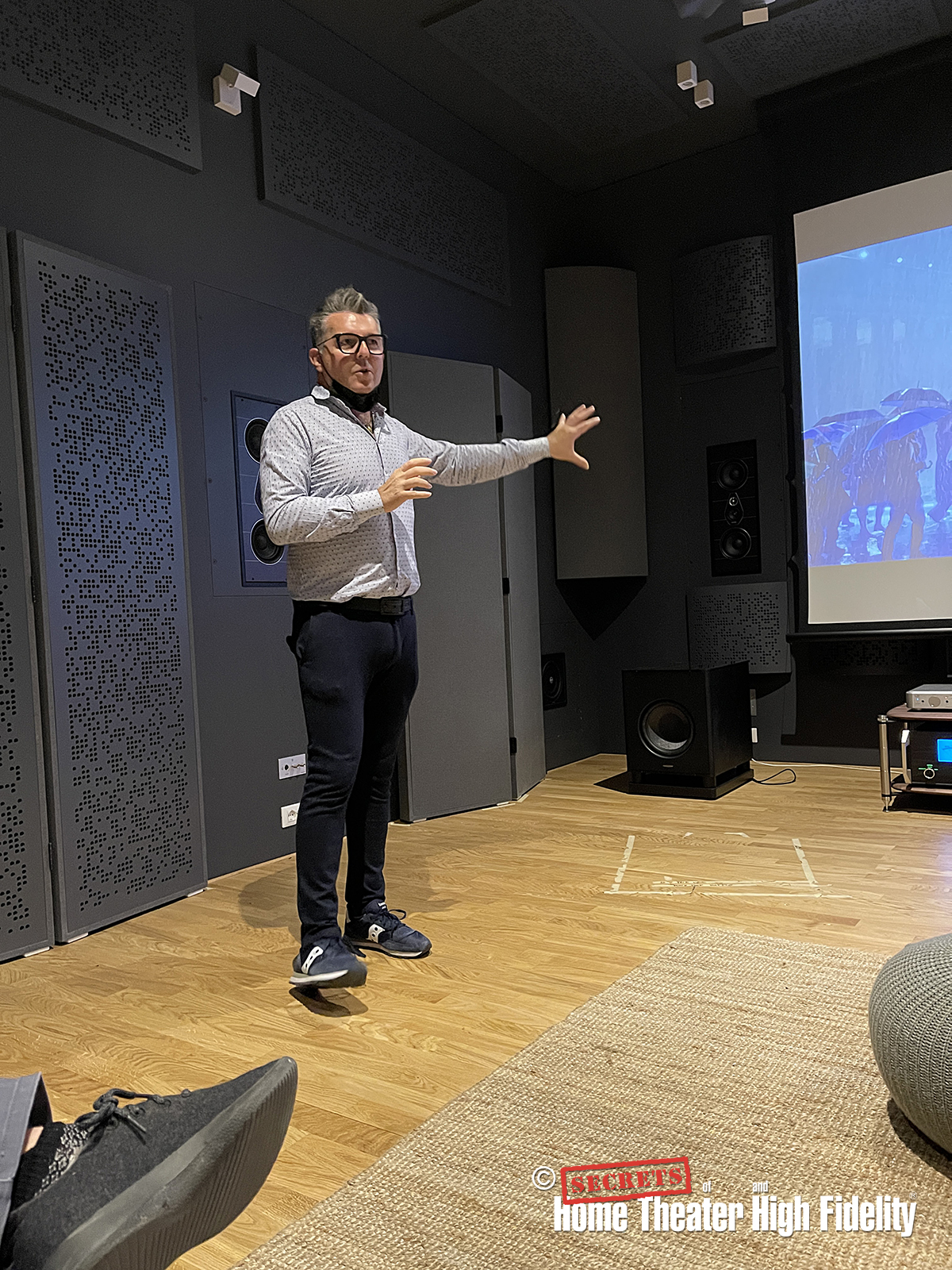
Roberto Gamba, Sonus faber’s Home Theater and Custom Install specialist.
Shuffling back to the Design Lab, we entered “The Grey Room” where we met Roberto Gamba, Sonus faber’s Home Theater and Custom Install specialist. Much like Paolo had done in the two-channel demos, Roberto had selected several movie and concert clips that he was going to demo for us through “The Grey Room’s” 9.4.6 channel system based around the Sonus faber Palladio CI speakers and four Gravis subwoofers. The whole shebang was powered by McIntosh electronics along with being controlled and calibrated by a Trinnov Altitude 32 processor. To say that the experience was immersive would be a significant understatement! Dynamics, detail retrieval, and object tracking were exceptional. Particularly outstanding was the bass calibration for the room. The tangible sense of detail and pressurization in the lower octaves was quite remarkable. Wonderful stuff and a great way to cap off the day! Off to dinner!
Secrets Sponsor
September 30th. This morning we again piled into the shuttle bus and began our drive to the outskirts of Padova to visit the two woodworking companies that Sonus faber exclusively uses. Let me preface this by saying that while not entirely certain about what to expect on this part of the tour, I have visited a few speaker manufacturing operations and so had a preconception of seeing large CNC machines and a lot of automated production commensurate with a company having the resources that Sonus faber does. What I would find however is that Sonus faber employs the talents of two small, family-owned artisanal wood fabricators/finishers each with a long, rich history of doing things very much by hand.
Our first stop was at De Santi, a small Italian woodshop that had specialized in the making of fine furniture and grandfather clocks when Franco Serblin came across them in the mid-80s. Serblin’s desire to use solid wood to build his speakers, much like fine musical instruments, and shop owner Luciano De Santi’s know-how with the material in question, led to a fruitful partnership. Now, almost four decades years later, De Santi (run by Luciano’s son Stefano) builds almost every Sonus faber cabinet here. The company is also responsible for the final finishing of all the matte loudspeakers. Any cabinet that requires a glossy finish is sent on to the other woodshop Sonus faber uses as they specialize in high-quality lacquering.
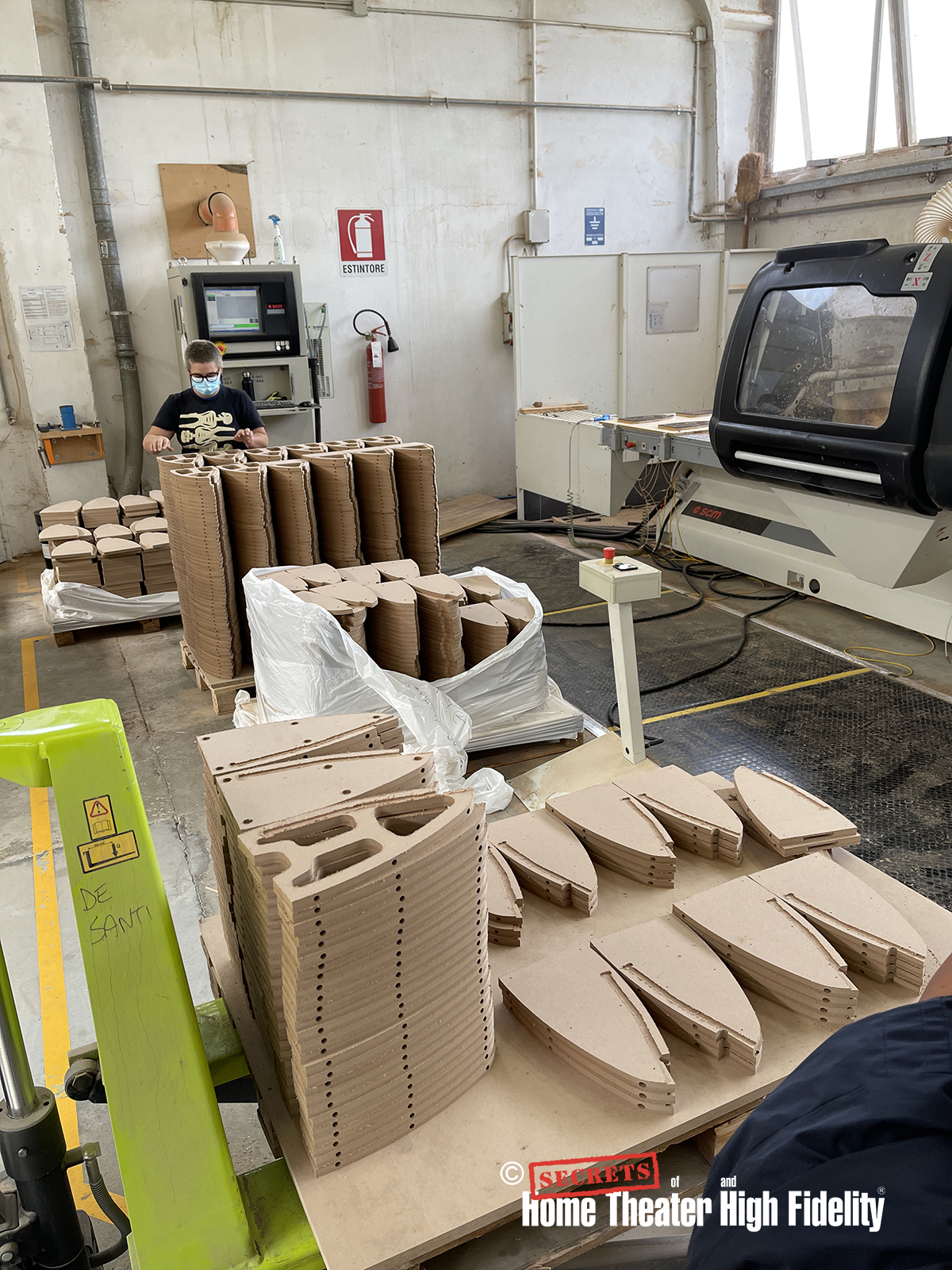
CNC Cutting of Internal Braces.

Grading and Matching Wood Grain.

Examining a Sheet of Walnut Veneer.
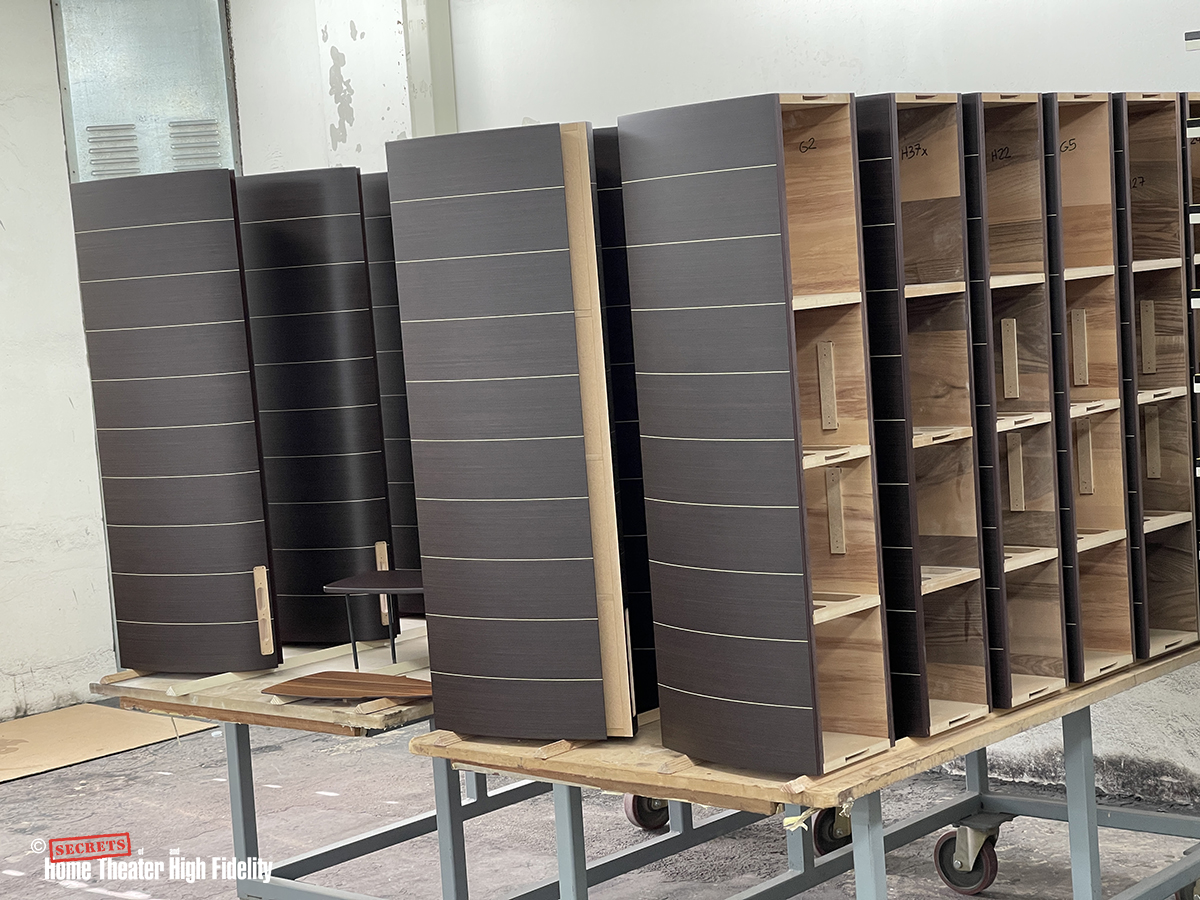
Completed Matte Finish Cabinets.
Walking carefully through the facility we can see every stage of enclosure production being worked on:
CNC cutting of MDF internal bracing, blocks of walnut and wenge being graded and grain-matched, wood drying stations, the bonding and slicing of veneers, the assembly, curing, and finishing stages. And yes, they have the machinery to help with precision cutting and so on but so much of this work is still performed by hand by skilled craftsmen with a wealth of experience. And they also mention the difficulties in finding youth that wants to be trained in this craft to comprise the next generation of artisans.
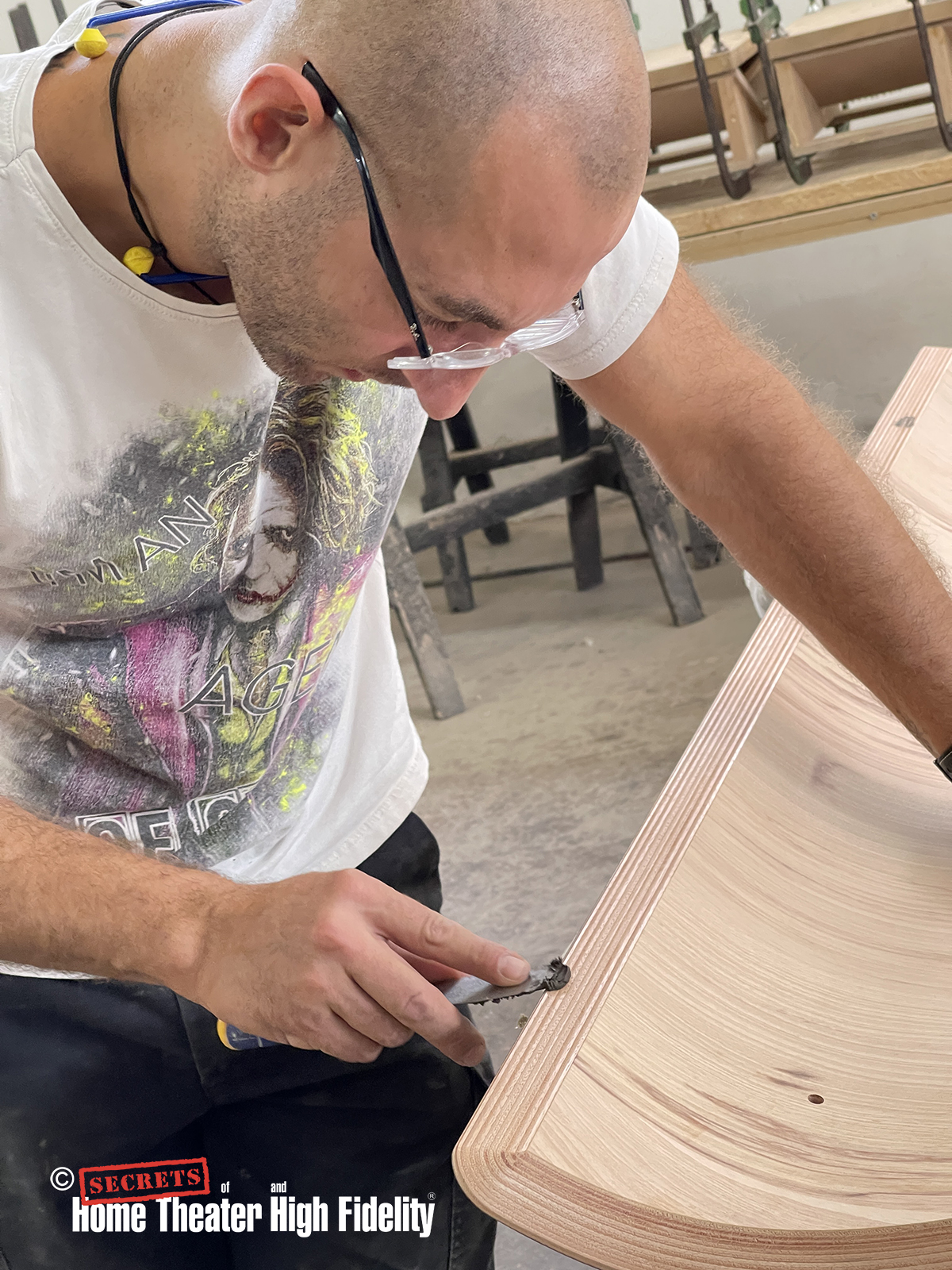
Artisan Examining and Filling Aida Cabinet Wings.
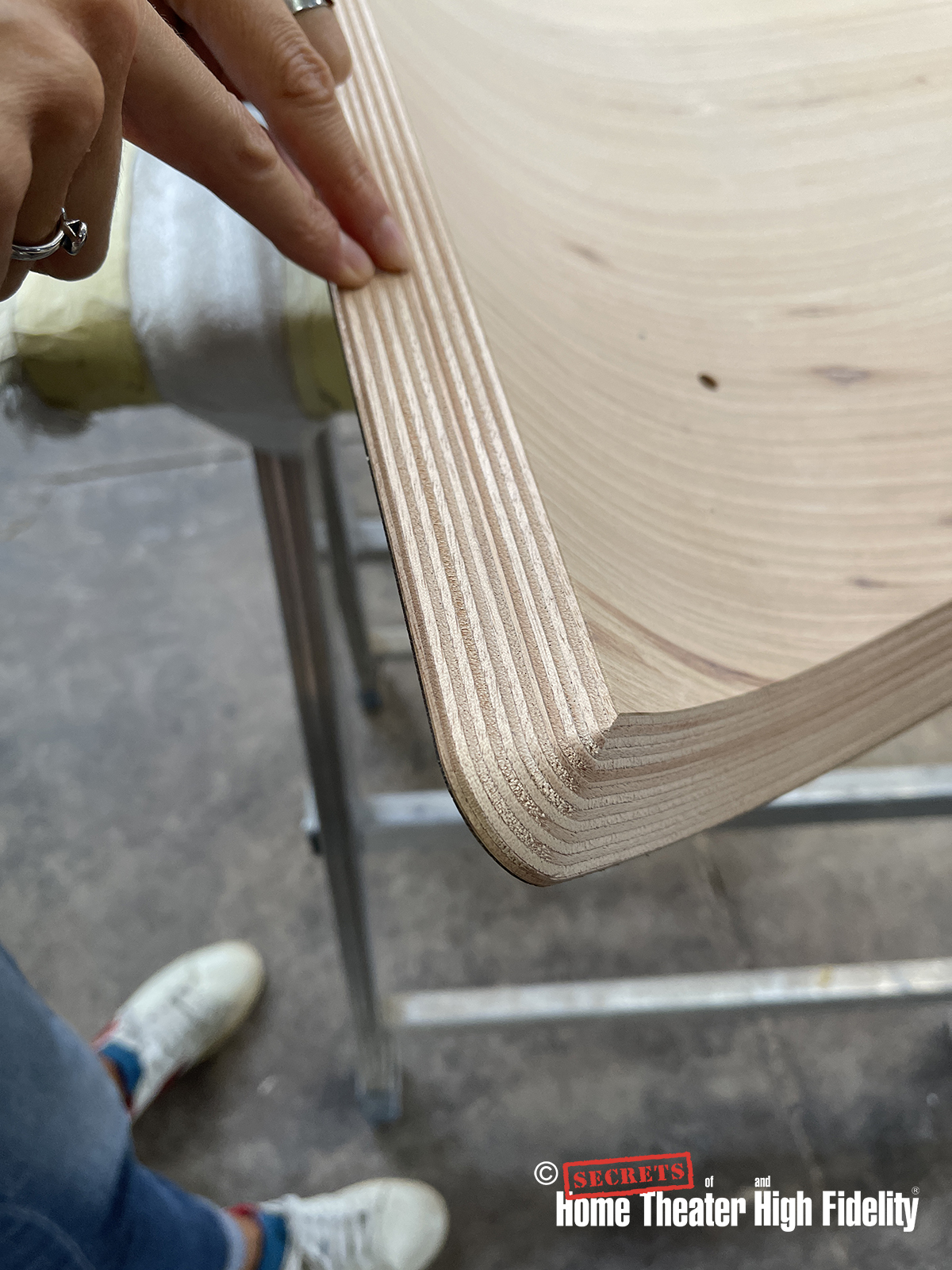
Close Up of Aida Cabinet Wing Layers.
Spying some Maxima Amator cabinets in their sanded raw walnut finish you can only admire the long swaths of solid wood that have been bonded together to make these creations. I speak with another artisan who is working on a set of the outer “wings” that are part of the Aida loudspeakers. He explains how each wing is made up of 15 layers of bonded beechwood ply, with the grain of each layer running perpendicular to the one previous, and finally topped with the outside veneer layer. Each wing is hand-finished to a state of raw perfection before being sent to the lacquering specialist. Ending our tour here, it just amazes me how almost every Sonus faber cabinet can come out of this modesty-sized (staff of 20) and very human operation.
Taking another short bus ride to the second finishing facility we soon arrive at Bi.sma, an even smaller operation than De Santi. As I mentioned earlier, this shop specializes in high-gloss lacquer finishes. They do all the finishing work for the Sonus faber’s Reference and Homage collections along with select McIntosh speakers that were designed and built by Sf.
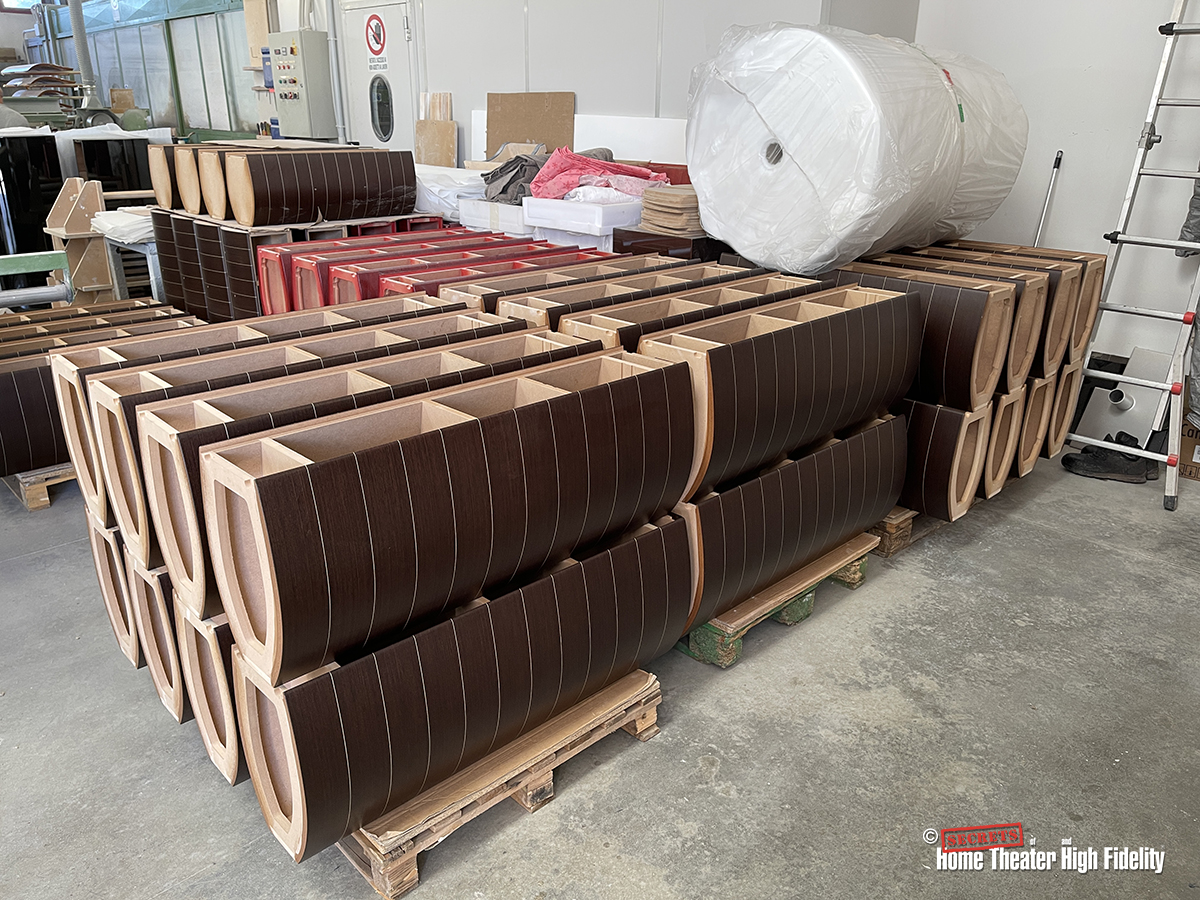
Cabinets Awaiting Sanding and Polishing.

Hand Sanding Before Polishing.
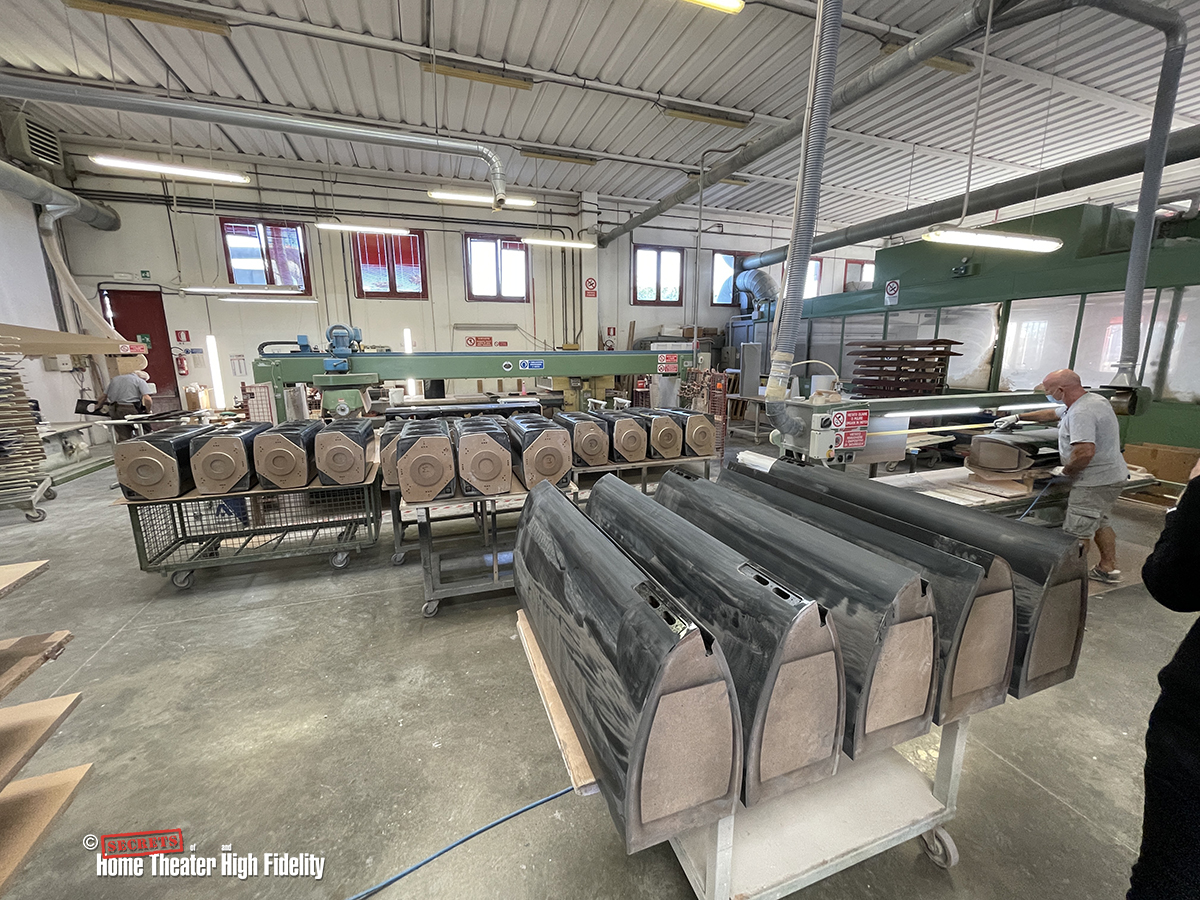
Right After All These Cabinets.
In short order, once the speaker cabinets are sprayed, they are air-dried in a special curing room for 30 days, after which they are alternately sanded and polished to a final glass-like finish. Bi.sma’s owner, Marino has been doing this work for over 40 years and is still active on the shop floor. My Italian came in handy here because I was introduced to Marino’s wife and once she heard me speak the language, she graciously began giving me a brief history of the operation. The shop got its start doing refinishing work on fine furniture and larger items like pianos. In time they got so good at it that they began doing piano restoration work for high-end clients like Steinway. We saw the just-finished glossy body of a black grand piano drying in a room separate from the speakers. Now, like De Santi, most of Marino’s production work is done for Sonus faber. According to his wife, Marino is in the shop every day, first to arrive and last to leave. Not because he must be here but because he wants to be. “This is his life, his passion” she proudly stated of her husband. “His hands touch every cabinet that comes through the shop.” I see Marino out of the corner of my eye, examining the glossy finish on some speaker front baffles. I approach and just quietly watch him while he scrupulously examines the final finish. Marino lifts and turns the wood at several angles to see if he can spot any surface imperfection under the light, then laying the panel back down he runs his hands over the length of it slowly to ensure that the finish is completely smooth. His eyes quickly look up, he acknowledges me with a simple nod and then he continues on with his work. I was informed that Marino was working on a special project so we were asked not to take photos of what he was doing, sorry. We finished up our tour of Bi.sma and headed back to our hotel and then a lovely dinner with the Sf staff to wind down, pick brains and generally let all we’d seen sink in. Tomorrow would be an early rise to get to Milan and catch my flight back home.
October 1st, 5:00 AM. Standing outside the hotel and waiting for my ride to the airport, the streets of old Vicenza were stone quiet but beautiful and peaceful in the light of the streetlamps. Running over the meat of everything I’d seen over the last two days, I was struck by how unique a company Sonus faber was. Like I’ve said, I’ve been to other speaker companies and talked to people who work at them and all have a love for what they do, a desire to do a good job, and an understanding that they are doing something kind of special. Sonus faber is the only relatively large speaker company I have been to that still has the feel of a small, boutique operation. It feels very much like a family and the whole Italian passion, artisan craftsmanship thing is not some cleverly contrived marketing slogan. It’s the real deal. You feel it while being here. The staff, the people in the assembly area, the woodworkers, the designers, they weren’t putting on a show for our little group of journalist interlopers. They were going about their jobs and were genuinely happy to have us find out about what they were up to.
In a time where there is a ton of research and scientific knowledge about what makes a good-sounding loudspeaker, the idea of making beautiful speakers out of solid wood, so that it resonates like a musical instrument and is integral to the final sound may seem incongruous by comparison. And yet Sonus faber has found a way to excel at this craft. Balancing the science and the art of speaker making to produce something truly special. Something that stirs all the senses. It was truly an enlightening and memorable few days.
Arrivederci, Italy. Till we meet again…


